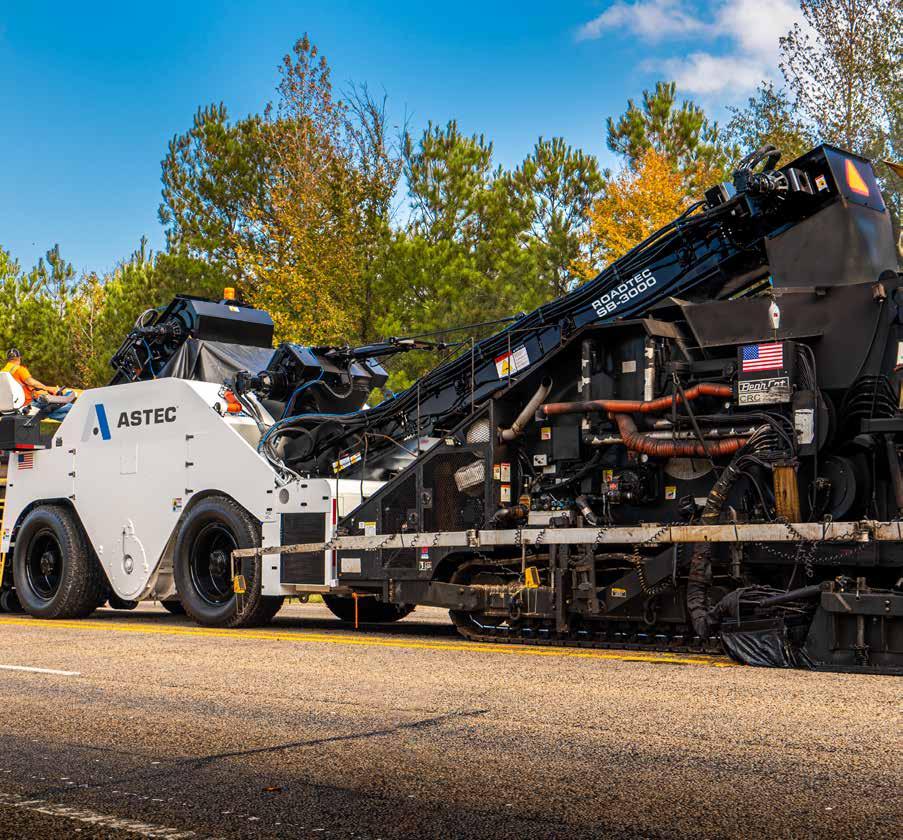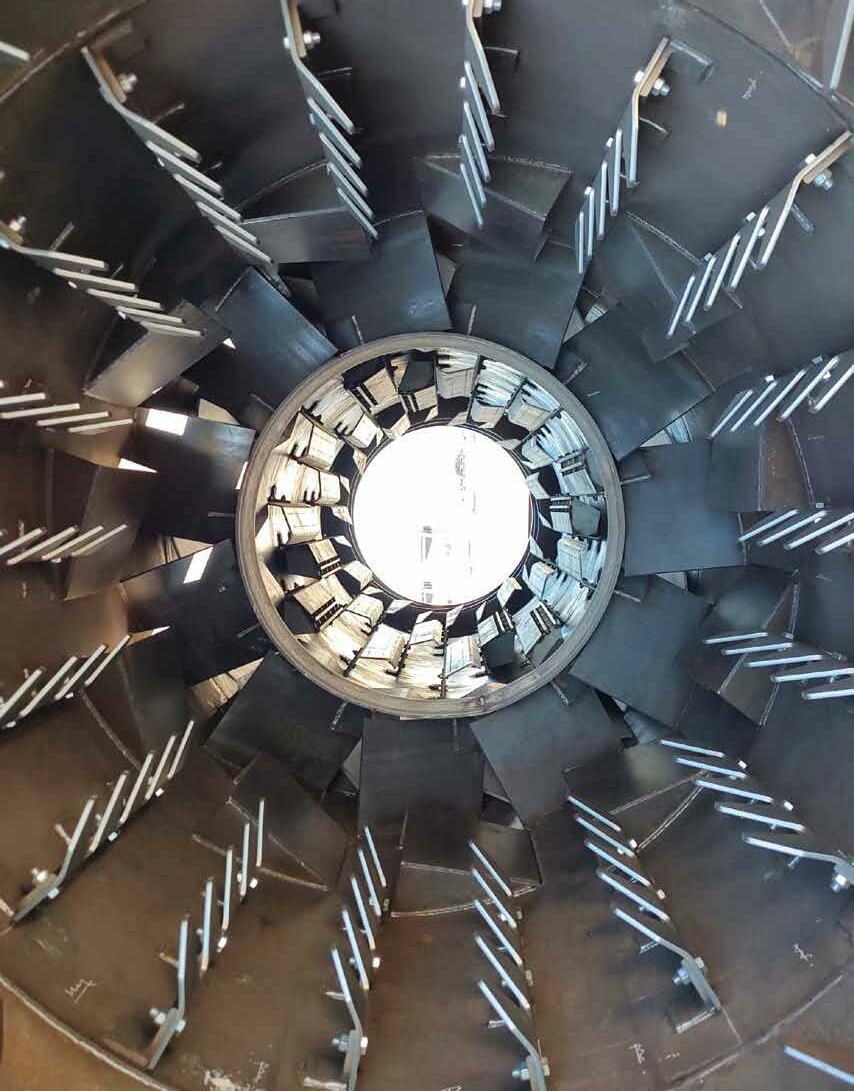

BUILT TO CONNECT
Sustainable Innovation
As a decades-long leader in asphalt plant innovation, Astec has introduced numerous products contributing to sustainability. From the Double Barrel® dryer/mixer introduced in 1988 to the debut of the high RAP Double Barrel XHR in 2016. In addition to these industry-changing products, Astec also leads in sustainability with our warm mix system, the V-PAC stack temperature control system, low emission burners, and blue smoke systems.
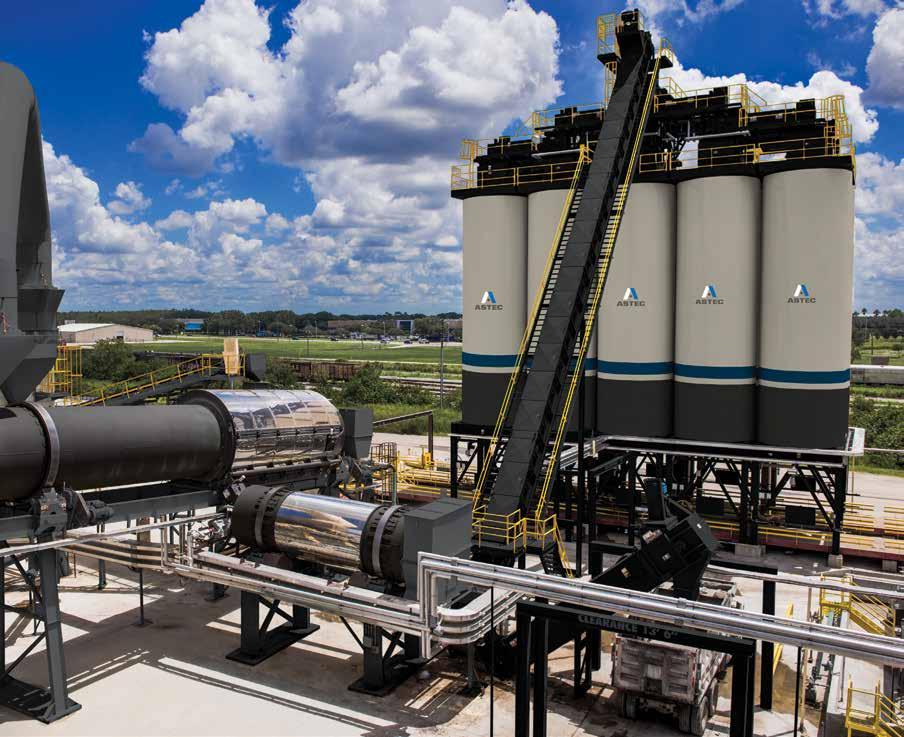
Astec is well-equipped to carry our culture of innovation into the future. Our dedication to sustainability includes new product development teams and an on-staff product manager for sustainability.
COME VISIT BOOTH C30235
MARCH 14-18, 2023 • LAS VEGAS, NV
Reach out to learn more about how we can help you meet your asphalt plant sustainability goals.

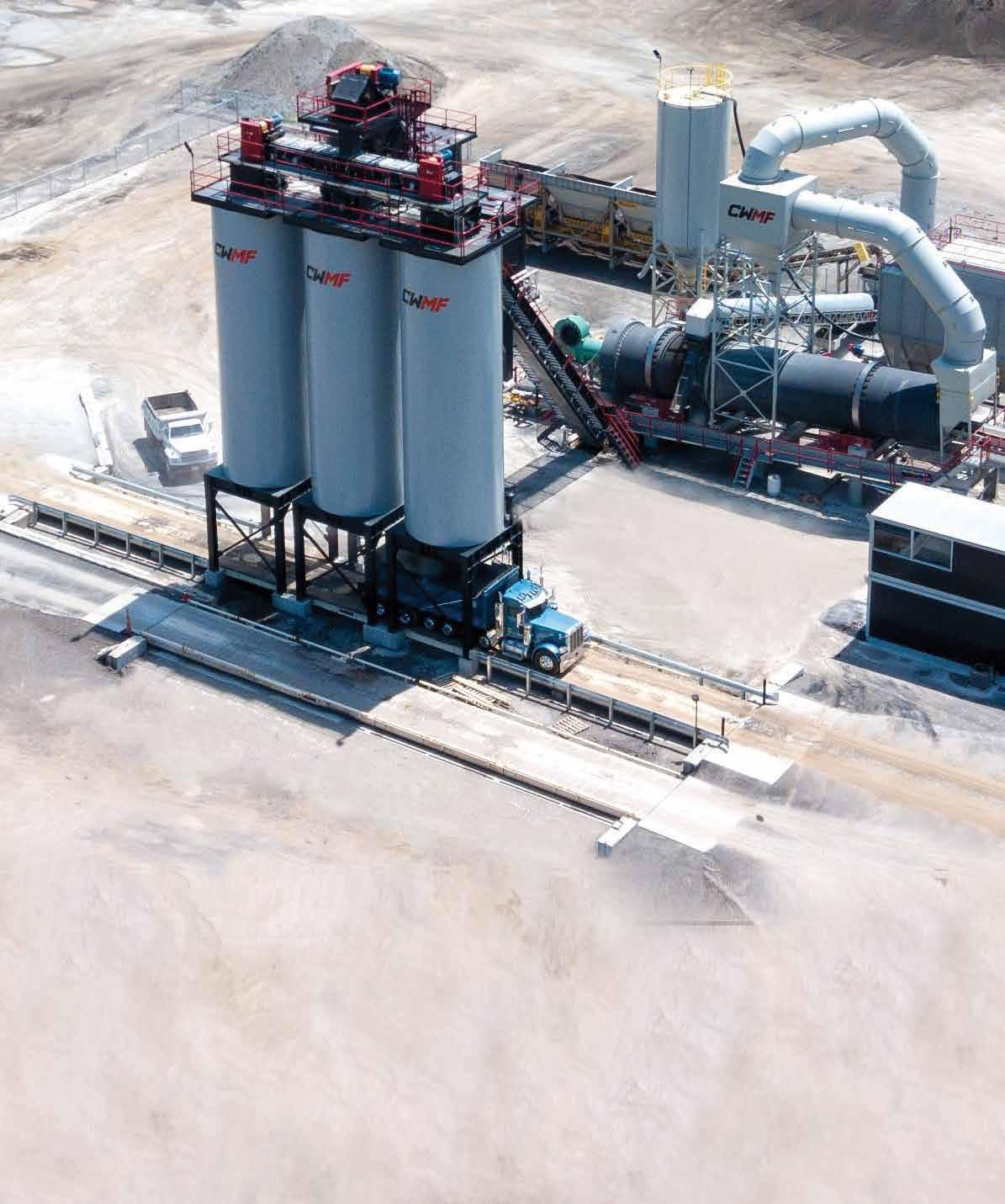

THE LEADER IN PERFORMANCE AND EFFICIENCY
At Gencor®, we’ve led the industry with the most fuel-efficient, environmentally clean and lowest-maintenance design available to the hot mix industry. Gencor Industries remains focused on proactively serving and satisfying its customers from all aspects.
Through improved cost-effectiveness, and quality of its products and services, Gencor’s personnel are dedicated to the principle of providing the highest quality to the industry to maintain a sustainable competitive advantage for Gencor®.
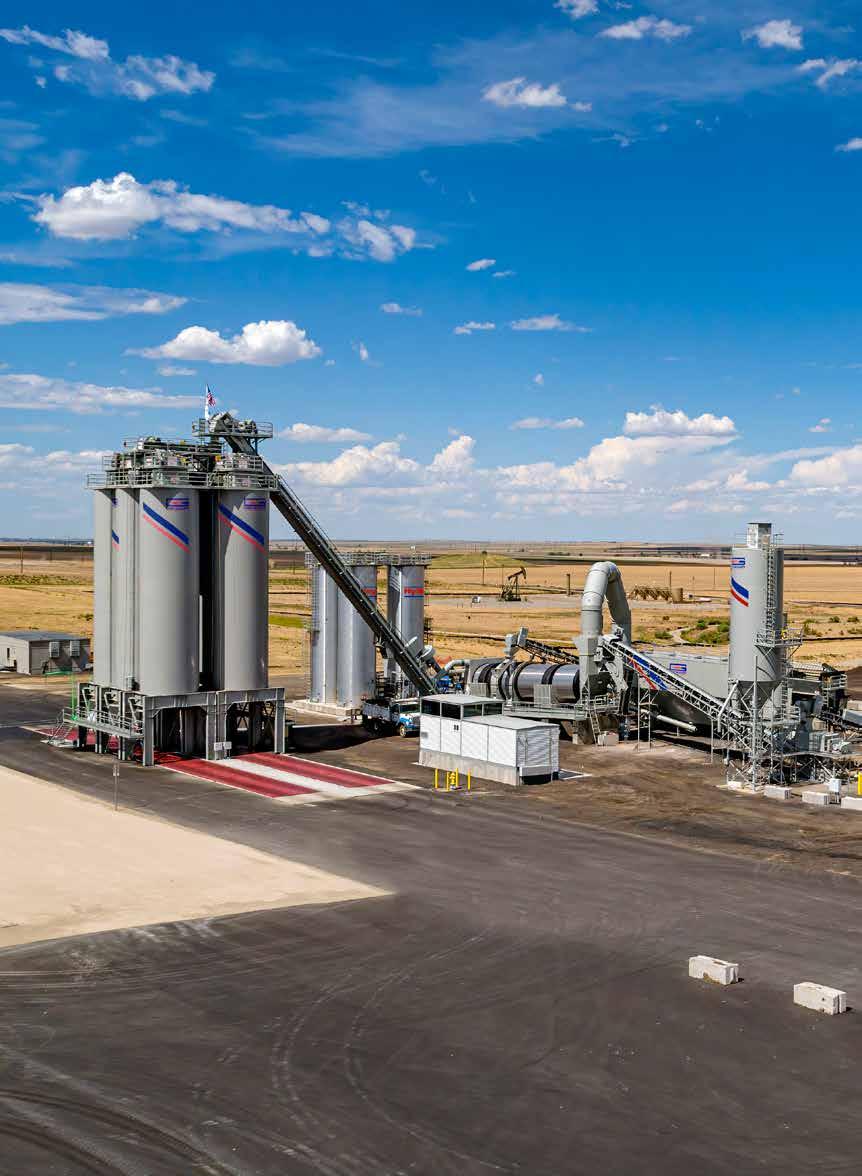
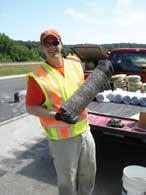
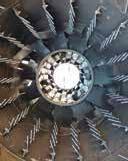
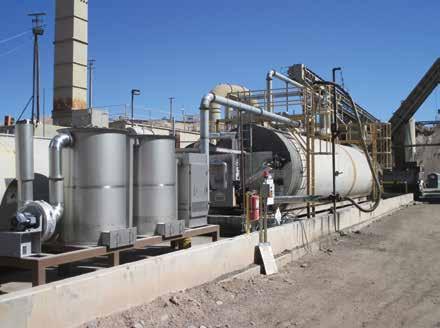
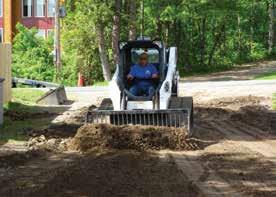
Word of Mouth
Ihope you won’t find this first note of the year to be too self-serving, but we have business to discuss. AsphaltPro readers, who typically understand the importance of sharing information and growing business alongside one another, will track with me easily here.
I’ll start by explaining something many of you know: I do a side hustle where I write wacky stuff about dragons and strong female characters who overcome adversity to save worlds from evil. Even with independent publishers doing the mechanics of publishing the books (there are no Big Five publishing contracts or advances in my impatient life), it takes word of mouth to let other humans know my titles are available for reading. It requires marketing, promotion, reviews on any review site we can find and so on.
Let me tell you how that relates to the asphalt industry.
In the asphalt world, we have a good, environmentally positive story to tell. We’re still innovating ways to reduce emissions that are already low. We’re still innovating ways to build pavement systems that will outlast our competition, thus reducing future materials use. What we need to do is be sure we’re marketing and promoting this good news to people who might not know it. Let’s leave some reviews of each other in good, positive terms that showcase how we’re saving the planet instead of backbiting on social media platforms. It would be in our collective best interest to nurture members of our crews into say nice things online.
Here’s an example. When your paving foreman sees a post online with a “smaller” paver, rather than pouncing on the opportunity to complain about his experiences with a similar model from that OEM, teach him to type in something about the warm-mix asphalt (WMA) being fed through the paver as an environmental win for that neighborhood. Is that cheesy? Of course, it is. Is that spreading better news for our industry? You better believe it is.
We also have an opportunity in front of us to increase our emissions-reduction
practices with financial assistance from the Department of Energy (DOE). I invite you to read Advanced Energy Property Deployment Part 1 in the December 2022 issue and Part 2 on page 24 of this issue for more information on the tax incentive and grant funding fog descending around us. Even if government guidance is still forthcoming, the concept of someday receiving a rebate for environmental excellence is enticing.
Keep your receipts.
Keep in mind, the reason we’re innovating advanced technology for asphalt plants and fleets is to continue improving. The goal is to make our industry the cleanest it can be. But don’t forget to share with friends and neighbors the continuing positive strides in your business. Don’t forget to tell OEMs you saw their information in AsphaltPro Magazine. Don’t forget the value of word of mouth.
I think that’s enough topics for one note. Dragons—which probably affect climate change—and defeating evil leading into marketing our good name leading into increasing our good name together. I think we’ll call that enough to lead us into a positive 2023. I wish all of you a safe, clean and productive upcoming construction season!
Stay Safe, Sandy LenderJanuary 2023 • Vol. 16 No. 4
asphaltPRO
602 W. Morrison, Box 6a Fayette, MO 65248 (573) 823-6297 • www.theasphaltpro.com
GROUP PUBLISHER Chris Harrison chris@ theasphaltpro.com
PUBLISHER Sally Shoemaker sally@theasphaltpro.com (573) 823-6297
EDITOR Sandy Lender sandy@theasphaltpro.com (239) 272-8613

DIGITAL EDITOR Sarah Redohl sarah@theasphaltpro.com (573) 355-9775
MEDIA SALES
Cara Owings cara@theasphaltpro.com (660) 537-0778

ART DIRECTOR Kristin Branscom
BUSINESS MANAGER Susan Campbell (660) 728-5007


AsphaltPro is published 11 times per year. Writers expressing views in AsphaltPro Magazine or on the AsphaltPro website are professionals with sound, professional advice. Views expressed herein are not necessarily the same as the views of AsphaltPro, thus producers/contractors are still encouraged to use best practices when implementing new advice.
SUBSCRIPTION POLICY: Individual subscriptions are available without charge in the United Sates, Canada and Mexico to qualified individuals.
One year subscription to non-qualifying Individuals: United States $90, Canada and Mexico $125.00. For the international digital edition, visit theasphaltpro.com/subscribe/
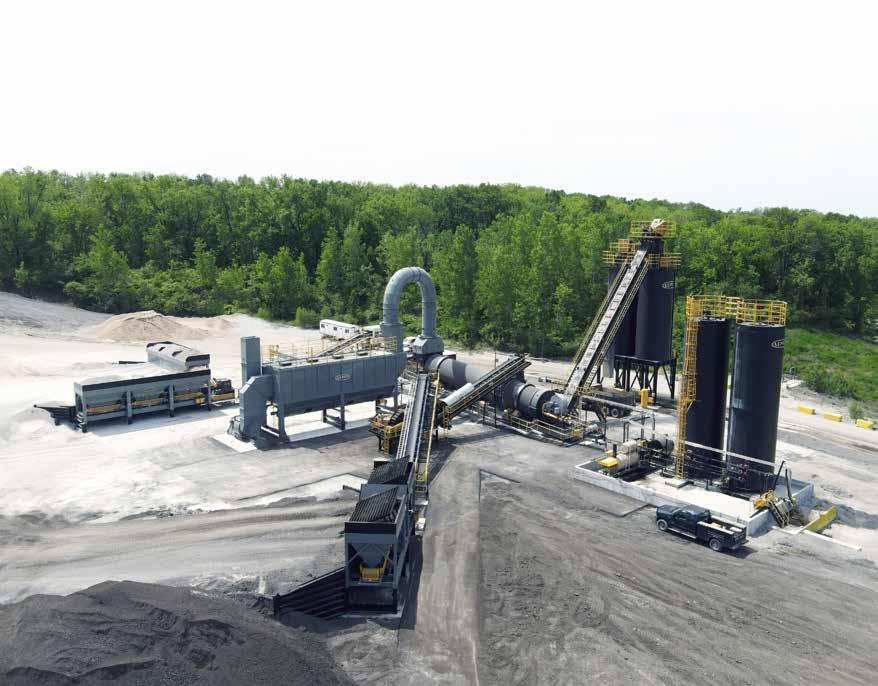


Palmer Sand & Gravel Wins Safety Gold
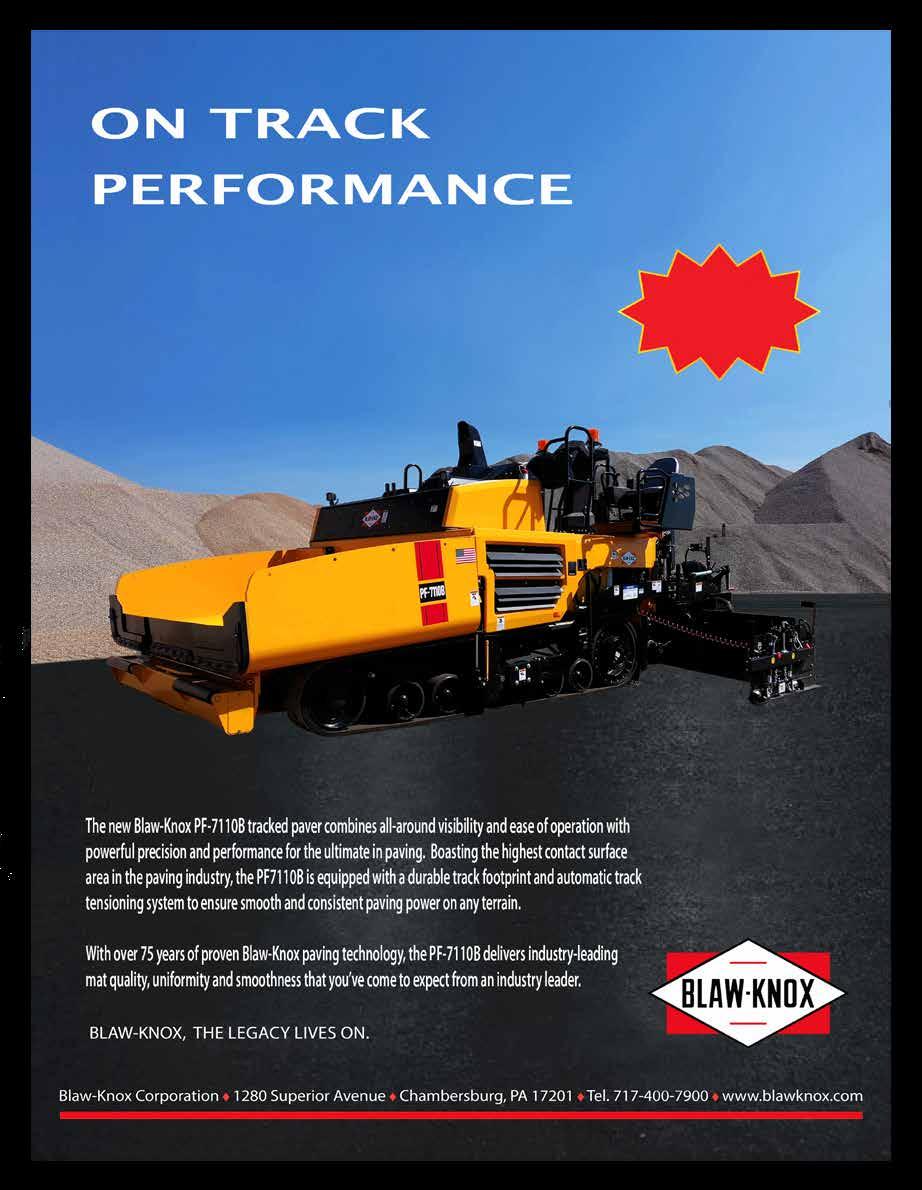 BY SARAH REDOHL
BY SARAH REDOHL
Palmer Paving Corp.’s Sand & Gravel operation, a Peckham Industries Inc. family company, has been recognized as the gold winner of the National Stone, Sand & Gravel Association (NSSGA) Safety Excellence Awards for the second year in a row. The Safety Excellence Awards recognize operations that maintain a safe workplace, evidenced by safety performance over a consecutive period without an MSHA-reportable injury.
“Our reportable injuries have been steadily declining for years, but we are always trying to get to zero,” said Steve Benton, corporate safety director for Peckham. “We call it ‘Achieve Zero,’ but it’s not just words on paper. It’s our company motto. We believe it’s our obligation to our employees to Achieve Zero.”
And Peckham is getting close—85% of its operations in 2021 achieved zero reportable injuries. To do so, Benton said Peckham, and its subsidiaries, have employed most of the traditional techniques and approaches, while adding a plan of its own. “We track recordable incident rates, lost time, etc., but most of those best practices are a bit reactive,” Benton said. To take it to the next level, Peckham would need to become more proactive.
That’s why the company introduced its Peckham Engagement Plan (PEP) in 2020. “We believe those closest to the risk should
have the most to say about it,” Benton said. “It’s a safety strategy that comes from the bottom up instead of the top down.”
“We started PEP to open up a conversation about safety and what we could be doing better,” Benton said. “We’re still following all the safety best practices after incidents take place, but PEP has been a powerful tool to be proactive about safety—and we’re seeing the program’s success in our numbers.”
The core component of the program is what Benton calls PEP observations. The company built a program in-house that allows managers throughout the company to report feedback they’ve collected from employees at all levels.
“We’ve trained more than 75 managers in our PEP process,” Benton said. This includes senior management, safety team, environmental team, QC team, sales team, superintendents and project managers, and some foremen. “We’ve been rolling it out incre-
mentally, but we’d like to get to a point where each individual employee can file PEP observations. I think that’s when we will start to make serious inroads in our safety culture.”

Whenever someone files a PEP observation, Benton and other stakeholders receive email alerts in real time. Every two weeks, they receive a report tallying all observations by location/operation.
“When PEP observations are done well, they clearly outline the issues and conversations that have been had with employees to come up with a solution,” Benton said. Most of the solutions turn out to be quite simple. “Most of it are just things that have been overlooked for years because it’s the way things have always been done.”
For example, the site manager at Peckham’s quarry in Patterson, New York, facilitated a safety brainstorming session with the quarry’s employees. The company had
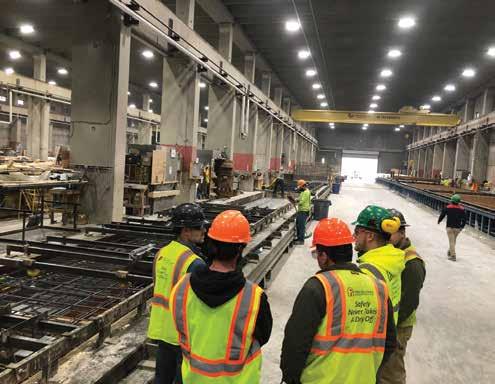
BENTON REITERATES THE IMPORTANCE OF ACTING ON EMPLOYEES’ SUGGESTIONS, ADDING THAT EACH TIME A SUGGESTION IS PUT INTO ACTION, “IT ENERGIZES OUR EMPLOYEES AND MAKES THEM FEEL MORE EMPOWERED.”


recently experienced an influx of new hires to that location and during the course of that conversation realized there was room for improvement within the employee orientation process. “The employees were able to walk us through what should be included in a new employee orientation process centered around safety and specific to that quarry,” Benton said.
Peckham was then able to duplicate the process for its other quarry operations. “That’s the power of Peckham,” Benton said. “We’re able to share best practices across all our operations.”
SAFETY SPOTLIGHT
LEARN MORE
Other outcomes from PEP observations include the trimming of tree branches obstructing visibility along haul routes and signage improvements. “These aren’t expensive capital projects,” Benton said. “It seems like such a basic concept and such simple solutions, but we’re already realizing the benefits of it.”
Peckham also strives to recognize employees and operations both for their engagement and for their safety performance. This includes recognition on the flat screen TVs located across Peckham’s operations, most often in break rooms, shops, and other places where other employees will see them. “We add some photos and text to recognize employees in real time and change them every week,” Benton said. The screens are also used to share safety tips, HR information, or learning lessons from incidents and near misses. “It’s been a great tool for an additional level of communication with our employees.” Employees are also recognized in Peckham’s newsletters.
In 2021, Peckham launched several safety awards, recognizing Peckham operations overall and by region: Most Improved, Overall Safety Excellence and Safety Champion awards. “The Safety Champion Award is named after Joe Wildermuth, who recently retired and was the epitome of a safety champion during his time with Peckham,” Benton said. Winners are nominated by Peckham’s regional safety committees and were awarded trophies made in-house in Peckham’s precast division.
The construction division, which includes Palmer Paving Corporation and
In June 2022, three Peckham Industries employees (Scott Pooters, Joe Sisto and Ahron Young) from its PARCO Terminal in Athens, New York, performed chest compressions and used an on-site AED on a truck driver who was experiencing a cardiac event.
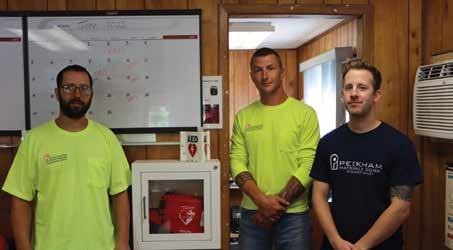
“Within the past few years, our employees have had to use an AED two times, on both occasions, a life has been saved,” Benton said. “In the first instance, it was an employee, and in the second, it was an owner operator who was transporting our product. Both of these individuals made full recoveries and are alive today thanks to Peckham employees that were trained and acted, utilizing company owned AED devices.”
According to Benton, all Peckham employees are offered First Aid/CPR/ AED training annually. This has been the company’s policy for decades. “We have hundreds of employees trained and continue to add more,” he said. “At some point in everyone's life, they are likely to encounter an emergency, and having the right training can make the difference between life and death.”
The company also has AEDs on-site—approximately 60 units at all its facilities. “Many sites have multiple due to the sheer size of the operation,” Benton said.
Peckham Road Construction, won the Overall Excellence award last year. “With no incidents whatsoever, it was an easy choice,” Benton said. The Most Improved Award went to the precast division, which cut its incident rates by 50% last year, and the Safety Champion Award went to Bill Perry at Dailey Precast.
“Not everyone is motivated in the same way,” Benton said, “but it seems somewhat generational. Employees today seem more motivated by recognition than they used to be. As a company, that means we need to change with the times.”
Plus, the recognition is well deserved. “This is a tough industry. At the end of the
day, it’s hard work and we need to recognize our people for going above and beyond.”
In the future, Benton said Peckham plans to continue expanding its PEP process throughout all levels of its organization and will continue to work very hard to Achieve Zero.
“We are excited to be recognized on a national level,” Benton said. “The recognition is great, but the real satisfaction is witnessing the employee engagement, including the implementation of solutions to reduce and eliminate injuries and accidents. Ultimately, it’s about getting them home to their loved ones in the same or better shape than when they arrived.”
This component makes it possible for you to never have to second - guess how much material is in your A.C. tanks or hotmix silos. The Accu-Level continuously monitors tank levels aler ting the operator when an over ll is approaching.
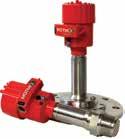

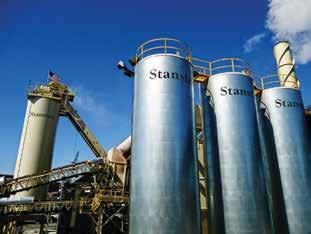
The app allows you to monitor speci c operations of your plant. While using it, you can: observe tank and silo levels in real-time, keep track of temperatures, monitor hot oil heater vitals, receive error alerts, allow team access, and more. Completely mobile-friendly, the app can be operated on a computer, tablet or any smart phone.

This system allows you to monitor and regulate all of your A.C. tanks. Users can set individual tank high/low parameters for level and temperature to initiate a pump shutdown and prevent tank over ows. In addition, you can operate A.C. tank supply, return, and ll valves with the push of a button from the control room, tank farm or any smart phone.

Bow Paving Solves Problematic Driveways with Simple Scarifier
BY JOHN BALLSometimes you can’t pull a great big piece of heavy equipment into a residential neighborhood to rip out an older, cracked driveway. For whatever reason, it won’t fit or it weighs more than the residential zoning will allow or what have you. While I was working with the crew at Bow Paving, Bow, New Hampshire, spring 2022, they brought a new attachment from Jenkins Iron and Steel, Long Prairie, Minnesota, to a pair of projects one day, and made quick work of preparing the subbase of two driveways. Let’s take a look at what they did and how your crew can learn from their work.
Robert Young Jr. is third-generation asphalt. He was driving truck for his father’s business, which was founded back in 1947, and started his own business in 2001. His company, Bow Paving, mainly handles driveways, parking lots and maintenance jobs.
Young works out in the field with his crew and can make decisions or handle changes on site. For the two driveways we worked on last
spring, having a decision-maker on site came in handy when a neighbor crossed the street and asked if we could handle a small project for them as well. Young was able to measure the extra job, estimate the cost, and add it to the day’s commitment of labor and equipment. That kind of flexibility is a bonus for contractors who can have a decision-maker in the field who understands what the crew can handle day in and day out, and what materials and labor cost the company day in and day out.
DRIVEWAY 1: DOWN TO THE SUBGRADE
For the first project in these pictures, you can see the team removed large chunks of asphalt from an older driveway with alligator cracking. They used a regular bucket attachment for the skid steer at first. When it came time to get the smaller chunks out of the subgrade, the operator, David Ordway, switched to the 78-inch scarifier attachment. They have a quick-release on their 7650 Bobcat, which makes the change from one tool to another easy for them.
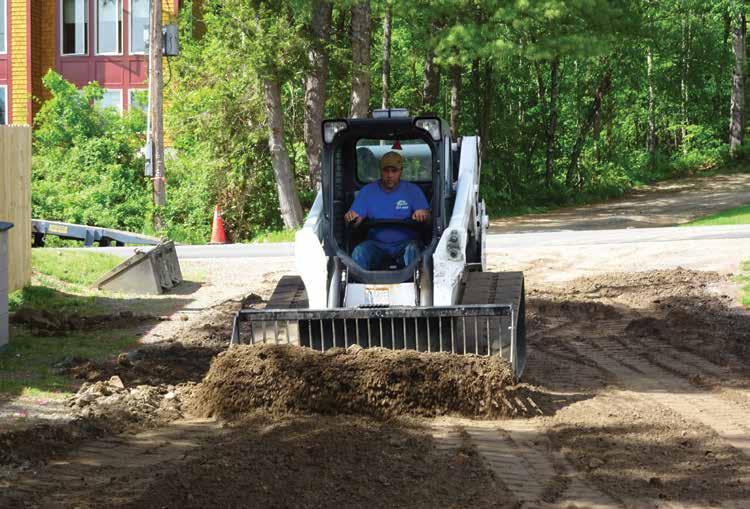
This change to the scarifier attachment allowed him to break up the subgrade, sift out the larger chunks, and leave the sand and dirt in place. Ordway tipped the bucket up to use its lip for grading. The back-dragging functions as grading the subbase, making it nice and smooth before filling in and paving.

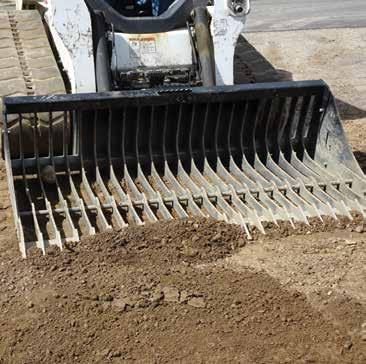
Next, the crew put in 6 inches of crushed gravel with the regular bucket and leveled that off. Then they paved 2 inches of base and 2 inches of top hot mix with their 5-year-old Leeboy paver. Because that machine is 5 years old, it has some wear to address; they needed to replace the loose depth cranks and needed to get heated endgates to perfect their process. With these updates, they’re poised for success.
They compacted the driveway with their Ingersoll-Rand roller, which is an older piece of equipment for them. Up next, they’re purchasing a Cat CB27 roller with a seat that slides side to side to allow the operator better range of visibility.
DRIVEWAY 2: EXPANSION WITH DRAINAGE
The second project in these pictures was more involved. You can see the team had a section of the project to sift and prepare with the scarifier attachment, again removing chunks and rocks so the subbase could be graded and smoothed for paving. This project required crushed gravel, placed with the regular bucket attachment, as the first project did.
The section of the driveway on the right-hand side of these images needed a French drain installed with Petromat to solve a water retention problem. Young uses a Topcon laser for measuring to know exactly how much material to order and place.
Here you can see the 78-inch scarifier attachment has caught a chunk of rock that would have otherwise contributed to problems in getting a smooth subbase.
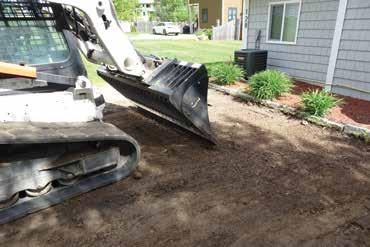

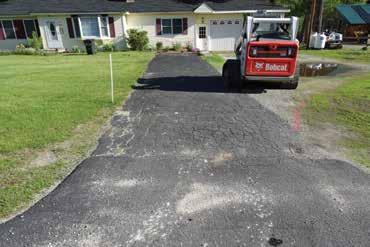
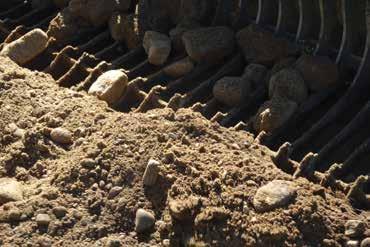
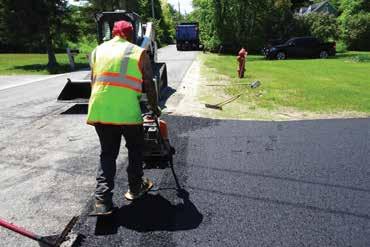
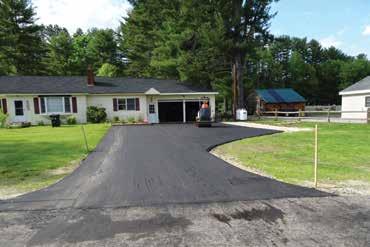
The team lined out the job before they started paving and noted the tonnage for each pass. This is critical and is how they control their yield.
For this project, they created five passes to get the flares even. Check out the “final result” picture on page 14. The first pass is 12 feet wide and comes down about 100 feet. The next is 14 feet wide and comes down about 100 feet to match the first. Then they set the paver over at the “end” of those passes to pave across the front and create the flare. The fourth pass began against that horizontal “lane” and pulled down to the road. The final pass was set up against the short stone wall next to the house and pulled all the way down to the road.
Notice they sawcut the unsupported edge. While this makes for a pretty edge, it also serves a quality purpose. It removes the potential for pavement raveling.

Other quality touches come from the team using a 2 by 4 to ensure the roller gets on and off the mat without crushing and crumbling the edge, using a plate compactor to seal edges, using rounded and squared tamp shoes for sealing up the edges against different structures, and having the truck driver use the leaf blower to keep the site clean during work. No one on the crew has time to sit around when it’s a small operation working hard to impress the client and build a top quality pavement.
John Ball is the proprietor of Top Quality Paving & Training, Manchester, New Hampshire. He provides personal, on-site paving consulting services around the United States and into Canada. For more information, contact him at (603) 493-1458 or tqpaving@yahoo.com.

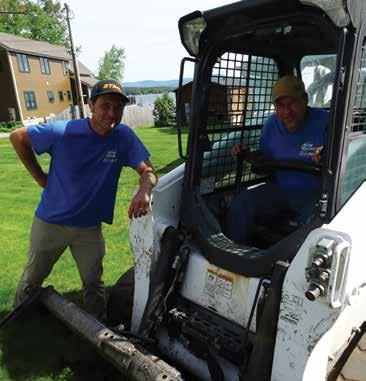
PAVEMENT MAINTENANCE
How to Repair a Utility Trench
BY ASPHALTPRO STAFFAfter a utility repair has been performed, it’s time to get the pavement put back in place. To execute this properly to ensure no water intrusion or raveling at the joints, a key step is preparing the walls of the trench, no matter their height. Getting clean surfaces that tack will adhere to is vital.
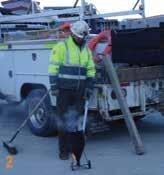
For the project in the pictures on this page, the crew not only placed two 5-inch lifts of hot-mix asphalt, but also placed 2 inches of aggregate over the electrical cable in the deep trench. Whatever your project’s requirements, make sure you follow this basic template for best end results.
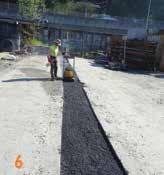
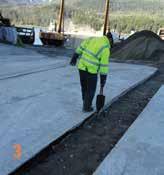
Step 1.
Hand-sweep the “walls” and edges. Clean off dirt and dust with a leaf blower to ensure the sides of the trench are clean.
Step 2.
If you don’t have a spray wand on your distributor truck, heat up the tack in a kettle and get the sides tacked efficiently. Make sure your team members know safe practices for working with 180-degree material and wear the appropriate PPE.
Step 3.
Use a skid steer, sidewalk paver, or good old-fashioned shovels and elbow grease to fill the trench with HMA.
Step 4.
Pinch both sides of the trench with a plate compactor to seal it against the existing pavement before compacting right down the center. You may have a large enough trench that you need a tandem roller for this step.
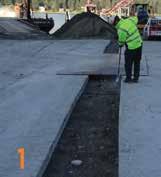
When the utility trench is complete, the roller operator will use a compactor to pinch both joints of the trench before compacting right down the center. For the example shown here, the team worked with a large enough trench that they required a steel drum tandem roller. Special Note: Keep bottles of biodegradable release agent on hand to keep all equipment free of asphalt buildup, as you see hanging within easy reach in this picture. All photos courtesy of John Ball of Top Quality Paving & Training, Manchester, New Hampshire
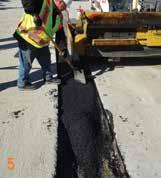
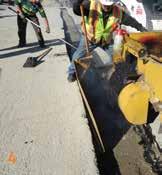
LEFT AND CENTER: This crew used a Road Widener attachment with conveyor belt in its hopper, affixed to the front of a skid steer, to put two 5-inch lifts of HMA on top of a 2-inch lift of gravel to fill in an electrical cable trench. Your crew may have a different way to throw mix into the prepped and tacked trench. RIGHT: Here the laborer uses a plate compactor to get the first lift compacted in the 3-foot-wide trench.
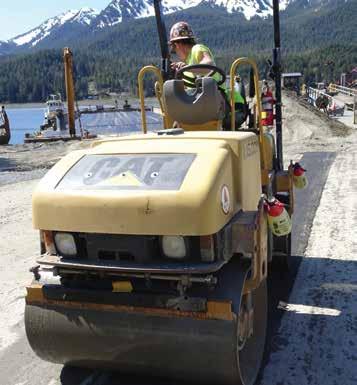

Making the Shift on S.T. Wooten’s I-40 Road Widening Project
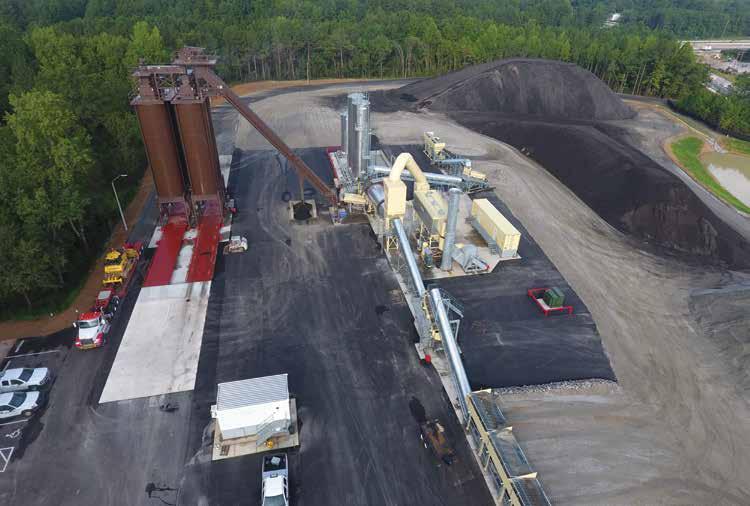 BY MATT DAVIS
BY MATT DAVIS
As temperatures began to rise this past spring, work was heating up on S.T. Wooten’s 13-mile highway widening project on I-40 between Raleigh and Clayton. From March through June, the project went through a series of traffic shifts to help crews transition into a new phase of construction while keeping traffic flowing for the traveling public.
This work signified a major milestone in the progression of the project and required a coordinated effort from crews and the leadership team. Weekend work, night work, rotating shifts and tight timelines make one traffic
shift a heavy lift. Completing eight such shifts in three months calls for even more hard work and careful planning.
KEEP UP THE PACE
For the I-40 expansion project, crews are adding two new lanes in each direction. Fourlane sections of the interstate will be extended to eight lanes and six-lane sections to ten lanes. S.T. Wooten is also managing construction of 15 new or revamped bridges and two new diverging diamond interchanges to help improve traffic conditions along this stretch.
Traffic shifts coincide with progress happening on the project, which began in 2018.
As work is being completed in one portion, establishing a new pattern allows for crews to transition to the next phase and keep traffic flowing for the public. At press time, crews were finishing up work in the outer lanes from I-440 to the 70 Bypass and hoped to complete the shift for the final pattern by spring of 2023.
THE RIGHT MIX
As crews have made strides to keep traffic disruptions to a minimum, paving work has been progressing on I-40. Existing lanes are receiving a 9.5-inch asphalt overlay on top of existing concrete. New lanes will use recycled

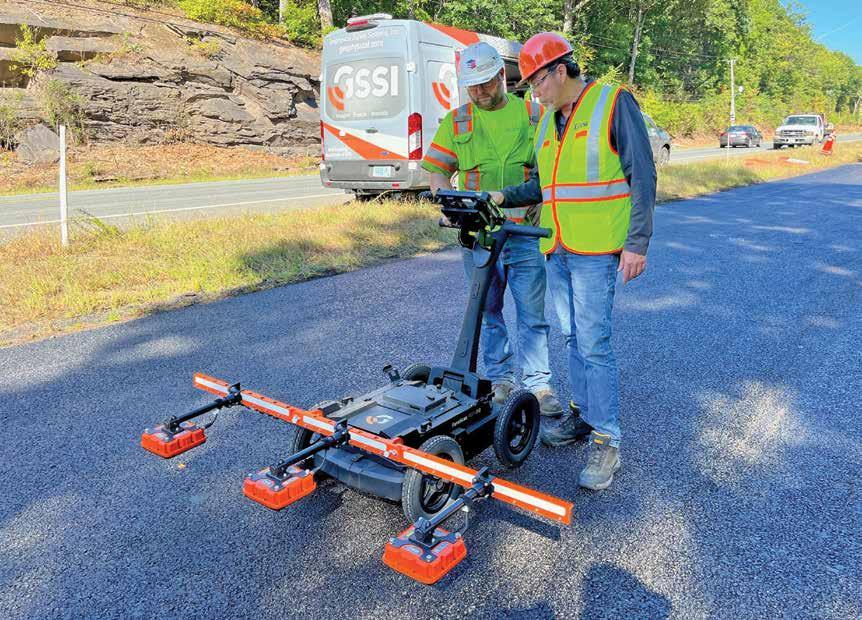
PROJECT MANAGEMENT
concrete from the old shoulders as aggregate subgrade. The base consists of a 12-inch layer of type 1 stone for the aggregate subgrade and 8 inches of ABC. On top of the stone is a 13.5inch asphalt structure that consists of multiple layers of base, binder and surface.
So far, about 600,000 tons of total asphalt mix have been placed on the project. Production has been supported by two asphalt plants that were installed adjacent to the work zone in the towns of Garner and Clayton to help alleviate some issues with traffic congestion. A temporary ramp was also created from a closed highway bridge that runs down into the median for easy site access.
With approximately 625,000 tons of asphalt left to be placed for the project, a materials conveyer will soon be installed from the Clayton plant that will give crews direct access to the site. The conveyor, in combination with the access ramp, will help save more than 42,000 loads from being hauled in traffic by the time work is completed.
TRANSITIONS ON TRACK
Traffic volume is the most consistent challenge on I-40 as thousands of commuters and travelers come through the area each day. Closing some of the lanes down for road work—even at night—is difficult for the public. That’s why work on each of the eight recent traffic shifts was scheduled for weekends to keep public interruption to a minimum.
This kind of weekend work can be tough on workers. Getting everything done before Monday means having to rotate shifts so work can remain continuous until sections are completed. In one instance, a ramp had to be closed for a weekend while it was being renovated. In just two days, crews managed to:
• Dig up the old ramp’s pavement.
• Install new drainage systems.
• Regrade the ramp area.
• Pave the new ramp back.
• Tie the ramp back in to the main line.
The traveling public isn’t always aware of the focus and hustle it takes behind the scenes to successfully complete all these activities on a condensed timeline. Construction crews work hard, day and night, to ensure the smoothest possible transition. They deserve a large amount of credit for the work they do to support the community.
For the management team, completing a complex series of traffic shifts can be a juggling act that requires an ability to adjust when it comes to planning and schedules for crews and subcontractors. Preparation isn’t only about the grading and paving work. Teams lay out the new traffic patterns, paint the lines, install temporary barriers and install signage to accommodate these new patterns.
Each component must be ready and work in synchronization. If one end of the new pat-
tern is paved and marked but the other isn’t, crews still will not be able to shift until the work is finished. The NCDOT has specific deadlines for when lanes must reopen—generally before rush hour traffic starts on Monday morning. If the lanes aren’t reopened on time, the company faces hefty fines, which are often calculated in 15-minute increments.
TEAMWORK MAKES THE DREAM WORK
While the work on I-40 takes enormous coordination, experience is on S.T. Wooten’s side. The company has worked with the NCDOT on multiple high-dollar state road construction projects. Crews understand what is at stake and the impact their work has for the ongoing success of the company. Accountability and close communication have been instrumental with so many moving parts on the project.
Collaboration across the board—from coordination between the quality control testing lab and plant crews to those working onsite—has helped the team avoid issues with mix or density during laydown as well. Teamwork will continue to be important as crews build momentum and ensure a smooth surface through the final stages of paving.
Thanks to the hard work from crews on I-40, the project is moving forward on schedule for the 2024 deadline. Around 400 workers, touching every division in S.T. Wooten’s company, will have played a part in its success. Continued teamwork and collaboration will ensure that each remaining milestone is achieved along the way and that the project gives the public something to be thankful for when the job is done.
Matt Davis is a project manager for S.T. Wooten Corporation.

THE CONVEYOR, IN COMBINATION WITH THE ACCESS RAMP, WILL HELP SAVE MORE THAN 42,000 LOADS FROM BEING HAULED IN TRAFFIC BY THE TIME WORK IS COMPLETED.About 600,000 tons of total asphalt mix had been placed as of press time with another 625,000 tons to go. The installation of a materials conveyer—from the Clayton plant—will give crews direct access to the site. The conveyor and access ramp will take more than 42,000 loads out of the traveling public traffic stream.
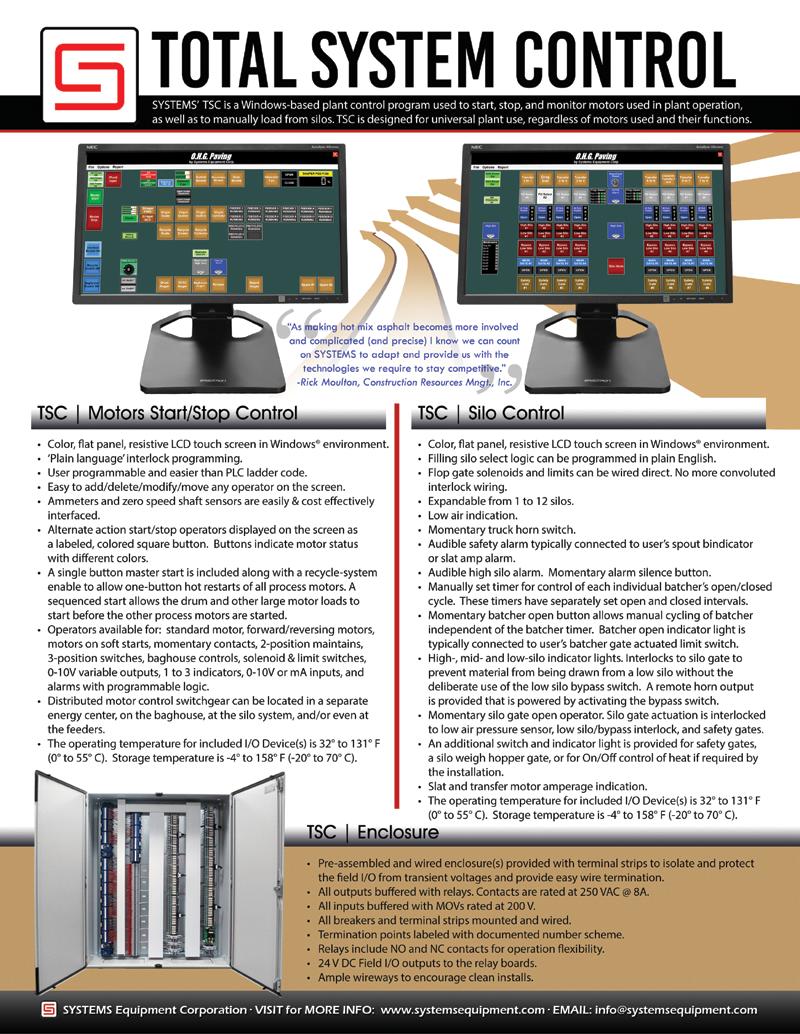
THE POWER
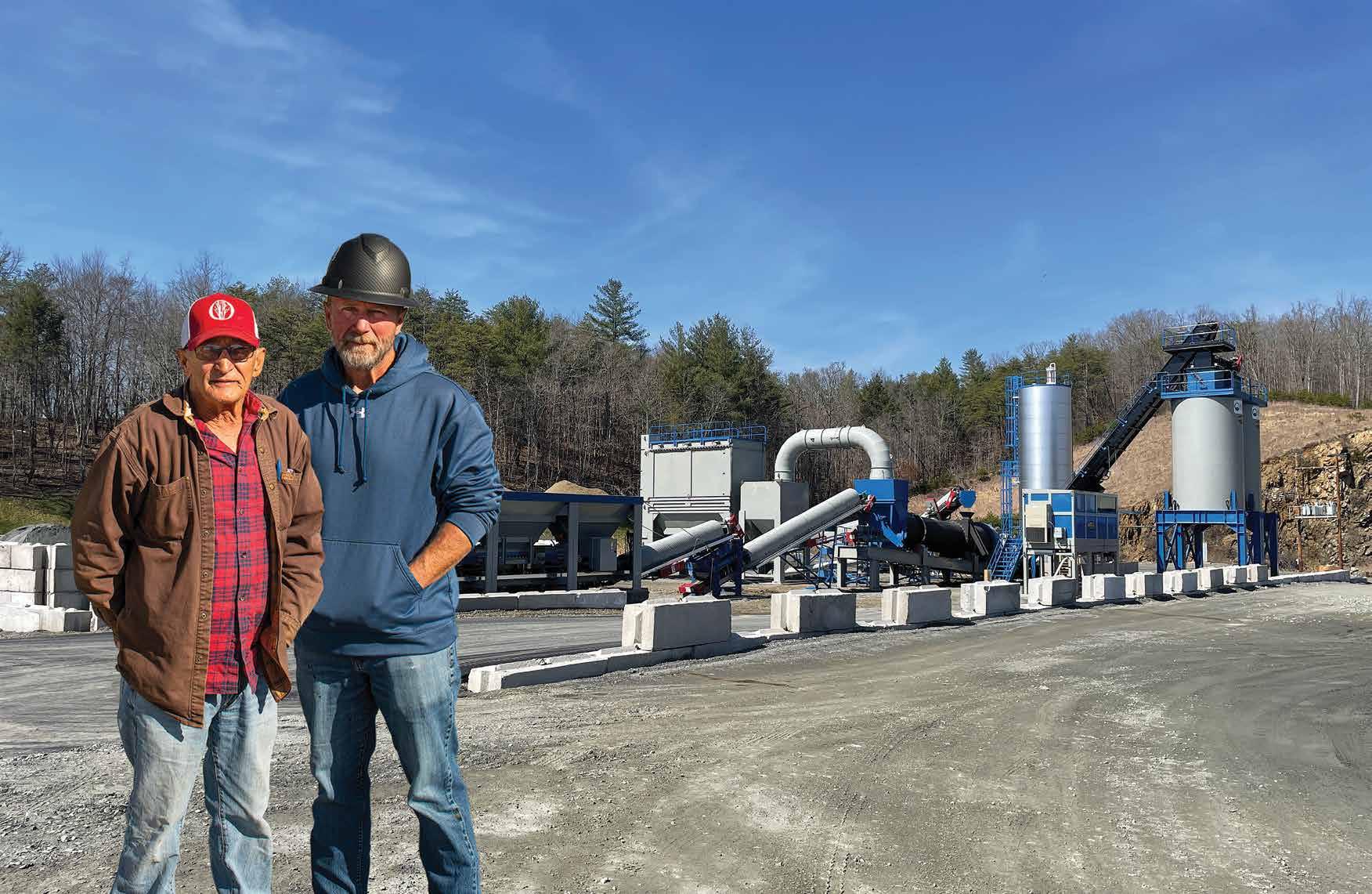

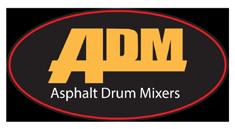
Butler-Justice offers the X-VOCS™ system, which is designed to eradicate invisible, odor-causing emissions at the hot asphalt storage tanks by incorporating a five-stage filtration system. In the first three stages, a series of filters remove more than 95% of targeted particulates down to 0.3 microns; in the final two stages, carbon filtration beds remove remaining odors and volatiles, according to the manufacturer. Photo courtesy of Butler-Justice
 BY SANDY LENDER
BY SANDY LENDER
AAs discussed in last month’s installment of this series, owners of hotmix asphalt (HMA) sites and quarries can not only upgrade existing facilities for their best environmental performance, but they can also receive government funding—eventually—for a portion of the cost. This was shared in detail during a National Asphalt Pavement Association (NAPA) member briefing held Sept. 8, 2022. During that briefing, Jay Hansen, executive vice president—advocacy for NAPA, shared information about the $5.8 billion available through the Advanced Industrial Facilities Deployment Program, through which facilities owners can receive rebates of up to 50% of the cost to design and install advanced technology at their plants.
The goal, Hansen explained, is to drive down greenhouse gas (GHG) emissions throughout many industries and the program is run through the Department of Energy (DOE). As discussed in both our November and December editions, one way to take advantage of available funding is through applying to the DOE for a grant to identify and install appro-
priate technology for achieving a more efficient operation. At press time, industry awaited guidance on grant funding.
In fact, during testimony at the U.S. Senate on Environment & Public Works’ “Putting the Bipartisan Infrastructure Law to Work: The Private Sector Perspective” hearing held Nov. 30, 2022, Gary W. Johnson, the vice president of Granite Construction Company, told the committee that his company is ready to apply for grants to subsidize the GHG-reducing measures it has put into practice. “Grant opportunities need to come online as soon as possible,” Johnson told the EPW.
You can view the entirety of the Nov. 30 hearing at this permalink, where you will also find links to the five individual witnesses’ testimonies: https://www.epw. senate.gov/public/index.cfm/2022/11/putting-thebipartisan-infrastructure-law-to-work-the-privatesector-perspective

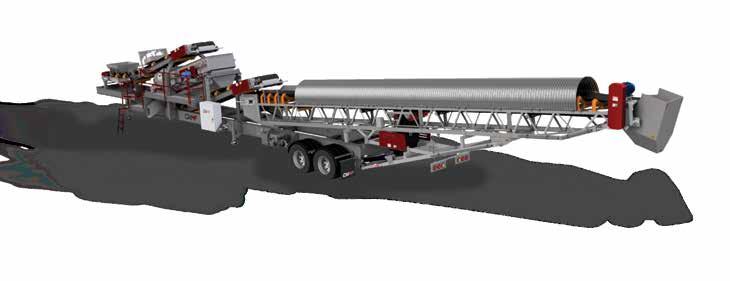

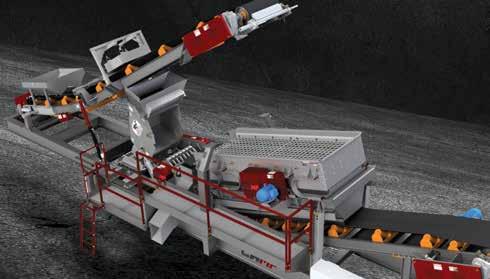
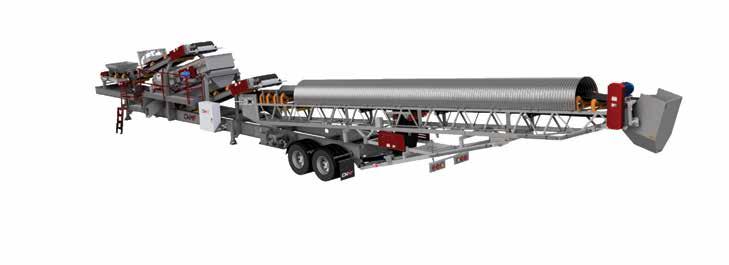
COMPONENTRY
As members of the asphalt industry are aware, producer members have been upgrading plant componentry to become more environmentally friendly and sustainable for decades. Gone are the days when a facility might emit dark clouds of smoke from questionable liquid asphalt cement (AC) purities, extreme production temperatures, lack of ductwork or baghouse, and so on; that’s something seen in old blackand-white photos from historical documents.
Instead, we have technologies such as pulsejet and reverse-flow baghouses, counterflow drums that capture gases and redirect them to a combustion zone for incineration, and blue smoke capture systems around loadout, transfer conveyors, and elsewhere, essentially negating blue smoke emissions. We have electric heating for tanks and Lo-NOx burners capable of burning any number of environmentally friendly fuels.
We have solutions to any problem.
Of course, the examples I list above represent merely a handful of the technologies asphalt industry innovators and entrepreneurs have brought to market over the years. And that’s what this article intends to share: ideas to encourage thought leaders to bring more examples to the readers who are interested in lowering emissions further.
Take a look at capturing fume specifically.
• Mike Butler of Butler-Justice Inc., Anaheim, California, spoke of his company’s patented Blue Smoke Control system, which is designed to capture and filter blue smoke from various potential emission points at the HMA plant. The company’s newest system for eradicating odor-causing emissions is the X-VOCS™, and it’s designed to filter and remove up to 99% of odors and volatile organic compounds such as hydrogen sulfide (H2S) from hot asphalt storage tanks. “These systems can be installed together or separately,” Butler said. “We can incorporate them into new plants or retrofit an existing plant with minimal modification.” That flexibility comes in handy for producers looking to upgrade for grant-filing purposes.
• The researchers at Astec Industries, Chattanooga, designed a blue smoke capture system called the fiberbed mist collector that removes hydrocarbons from the incoming gas stream. This system captures minute particles from a gas stream and allows them to coalesce into droplets, which are heavy enough to fall through filters. Check out the Here’s How it Works feature from December 2021 for a detailed explanation.
Take a look at burner technology next. While some permits specify plants must have a Lo-NOx or Ultra Lo-NOx burner to begin operation, there are ways to increase the efficiency of these already advanced technologies. Mike Mauzy of Reliable Asphalt Products, Shelbyville, Kentucky, shared how one of his clients uses the Vulcan burner at his plant.
“Asphalt Supply Company (ASCO) in Sellersburg, Indiana, conducted a plant upgrade in April 2022, which included a new Vulcan 120 million BTU burner firing on natural gas,” Mauzy shared. He reported that ASCO immediately experienced noticeable fuel savings. Brandon Watson, ASCO’s general manager, told Mauzy, “Over the next few months, we realized a 20% average reduction in natural gas usage.”
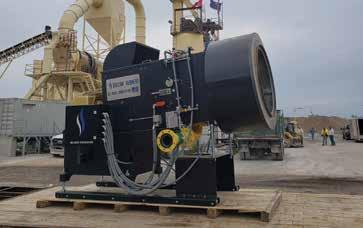
This improvement remained consistent since the April installation into late October 2022, when Reliable Asphalt Products, the North American supplier and manufacturer of the Vulcan burner, conducted a water injection test on the ASCO Vulcan burner. By introducing water mist at the fuel injection point, it has been proven that NOx emissions can be reduced even further. This test resulted in a NOx reduc-
tion while simultaneously increasing mix temperature and reducing natural gas usage even further.
“Further tests are forthcoming, but we were very encouraged with the threefold improvements by simply adding a small amount of water to our burner,” stated Dennis Mauzy, the Vulcan burner sales and service general manager.
As discussed in last month’s article, electric heat can be employed to reduce emissions all around the tank farm and yard. Ron Herman, business development manager of Enerquip Thermal Solutions, Medford, Wisconsin, listed a number of basic “hot spots” he recommends customers look at for energy and money savings. Among those is the use of LoNOx or Ultra Lo-NOx on burners, as mentioned above.
Herman also discussed replacing tank fire tubes with bottom-mounted tank coils, which can remove an emissions source at each tank on the site. When sitting down with customers to make a list of least expensive to more high dollar investments in energy efficient changes or upgrades, one of the first things Enerquip looks at is replacing inefficient tank coils or adding coils in those tanks without them. For example, if a customer is using older technology such as direct-fire heat at the tank, that customer is working with a small emissions source at each and every tank. That can be eliminated by switching to coils that are fed by a hot oil heater or electric heat, Herman said.
“For customers that already have tank coils, we’re looking at the type and efficiency of the coils they have in there,” Herman said. Depending on the technology of the coil, it could encourage coking, increased energy demands and higher maintenance activities. “We provide tank coils with helical-wound coils, which stand vertically so they’re like little discs around the pipe. Any sediment that tries to settle will fall between them and settle to the bottom to be cleaned out during their preventive maintenance programs.”
With this type of system, the producer can experience more heat transfer per foot than with other systems because there are so many more “fins” per foot. “There’s more heat transfer per foot; they’re more efficient so it takes less energy to heat the tank; and they’re not insulating themselves with sediment,” Herman said. In summary, a producer “can gain 10 or 15% efficiency just by switching out tank coils.”
BIG PICTURES
Another resource that shared a list of steps with producers was Intrame, a plant manufacturer in Spain. The spokesperson recommended a host of best practices when seeking to lower one’s carbon footprint and emissions output.
It takes a road to get there.



And a world of experience to build that road. As the global leader in road construction and minerals processing technology, we‘ve seen just about everything there is to see. In every climate, every condition, every twist, turn and terrain. And we put that world of experience in your hands, so you can experience exceptional performance and results at every phase of the road construction cycle.

 WIRTGEN VÖGELE HAMM
WIRTGEN VÖGELE HAMM

• Increasing the RAP in the mix designs
• Reducing the temperature of the mix, by:
o Using foaming systems
o Using additives as waxes
o Using emulsions, etc.
• Using gas instead of other fuels such as heavy fuel, diesel, RFO, etc.
• Using electrical heating for the tanks and lines
• Using adequate venting systems in the tanks
• Covering bins and stockpiles to reduce the increase of moisture with the rain
• Reducing wastes during plant start up and stop
• And of course, try to design the plant with as much energy efficiency as possible.”
When designing the whole plant, the team at Gencor Industries, Orlando, has taken its Gencor Ultraplant seriously. Dennis Hunt of Gencor, spoke of the Ultraplant’s design. He stated the individual components are optimized in design “with the intention of maximizing thermal, mechanical and heating efficiencies—all contributing to the reduction of greenhouse gas emissions throughout the United States. Gencor hot-mix asphalt plant design has reduced conventional energy usage to the lowest level attainable to produce hot-mix asphalt for roadbuilding and infrastructure development.”
What readers should keep in mind is this is a goal of any original equipment manufacturer (OEM) now. The OEMs are working hand in hand with customers to find ways to reduce energy use while keeping up with production demands. Herman at Enerquip spoke to this concept, explaining he runs equations for customers to show how they can save energy—and money—by insulating their tanks. We spelled it out in the first article for you, but the point is insulating tanks—and maintaining insulation—will make an enormous difference in thwarting energy loss and reducing heating costs.
“That’s one way that they can save without really investing in any new infrastructure or equipment,” Herman said. “It’s instant energy savings just by insulating their tanks. That doesn’t make us any money; we don’t sell insulation. But that’s one thing I preach to my clients because it’s such a big impact that often goes unnoticed.”
Hunt also pointed to the importance of insulation going into 2023. “The Gencor Ultradrum rotary dryer is fully insulated,” Hunt shared. “Insulating the rotary dryer not only helps maintain a uniform operating shell temperature throughout the length of the dryer but is part of an ongoing Gencor effort to increase overall thermal efficiency of the drying system. A system designed to produce 400 TPH of hot-mix asphalt with full Ultradrum dryer insulation will see a reduction of 887,328 pounds per year in GHG emissions.”
Modern plants require more than insulation to keep energy use down. The spokesperson for Intrame suggested a list of tasks, which many producers already implement, but which serves as a good reminder of best practices.
• Increase the RAP capacity of the plants. (Of course, authorities must permit these mix designs.)
• Retrofit the plants with modern foaming systems
• Retrofit the plants with additive systems
• Retrofit the plants with covers for the bins and for the stockpiles
• Retrofit the plants with cold mix production system
• Change or adapt burner to be able to work with natural gas
• Consider electric heat for new plants
• Modernize plant automation and controls to reduce wastes during plant start up and stop
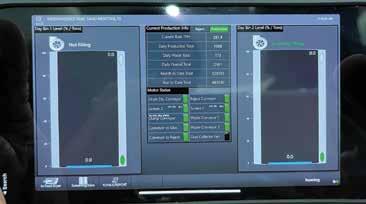
Looking at controls, as the Intrame team suggests in its final bullet point, is something Ron Heap at Tarmac International Inc., Lee’s Summit, Missouri, reminded producers to consider as helpful new tech in the New Year. “PLC controls for asphalt plants have been available for years and can be diagnosed and updated over the internet,” Heap shared. “New PLC systems not only replace obsolete electrical components but can now collect plant operating data and present this to management on daily, weekly, or monthly reports and give real time plant operating variables over “dashboard” data to management phone or tablet. Data acquisition and distribution gives management operational data wherever you are.”
Heap offered advice to keep the supply chain from hampering your upgrading plans: “Order your equipment early as burners, burner controls, larger motor control panels/motor control centers, baghouse ID fans, and dryer trunnion bearings have long lead times. Also, before you order a burner, find out if new lower NOx and CO levels will be needed. If so, then adjust your burner purchase to match the emissions required.”
CLARITY
Looking at that first bullet point the Intrame team suggests regarding the implementation of higher RAP percentages in mix designs takes us back to the Nov. 30 hearing mentioned at the outset of this article. Multiple witnesses at the EPW hearing stressed the need for clear, consistent regulatory guidance. And they weren’t limiting their desire for guidance to grant applications.
Dave Bauer, the president and CEO of the American Road and Transportation Builders Association (ARTBA), used the waffling legislation of the Waters of the United States (WOTUS) as an example when asking for “regulatory clarity” and “regulatory certainty.” But Granite’s Johnson made it clear in his testimony that our industry could indeed increase higher RAP percentages in mix designs if our industry had the regulatory certainty to do so. Johnson shared that in 2021, 16% of the material in Granite’s asphalt was recycled. That percentage increased to 21% in 2022. He said, “We could do more,” if the state agencies were more consistent.
In other words, clear, consistent regulation that allows for innovation will result in an industry that pushes for excellence. Turning on the switch that allows the industry to apply for grants to innovate, install and implement advanced technologies for the reduction of emissions will result in an industry that increases its innovations and deploys advanced energy property technology.
Whether producers are looking at upgrades to take advantage of grant monies, to apply for tax credits, to placate encroaching neighbors or to find new ways of lowering already low emissions, they don’t have
“We suggest, to reduce carbon footprint and emissions, the following actions:A plant manager or other member of management can see and react to plant operational data in real time these days, which makes any inefficiency that might be creeping into production easier to notice and resolve before it becomes a problem. Photo courtesy of Tarmac International



to go it alone. OEMs and consultants are willing to help when regulatory agencies come knocking at the door, whether you’re applying for grants or not. Butler shared: “For instance, the New York State DEC has proposed new air regulations on blue smoke control at asphalt plants that affect liquid asphalt storage tanks, hot-mix asphalt storage silos, pugmills, truck loadout, and drag conveyors.”
Producers doing business in that area might not be ready to apply for a grant from the DOE but would need to be ready to prove their environmental compliance under this proposal.
“Similarly, The Utah Division of Air Quality is considering regulation of VOC emissions from hot-mix asphalt plants as part of its Northern Wasatch Front (NWF) Ozone State Implementation Plan (SIP),” Butler continued. “This proposed rule would require HMA plant operators to control both VOCs and blue smoke emissions in the production and loading of HMA and at asphalt storage tanks. With minimal modification to their plants, producers can install our Blue Smoke Control system, which captures blue smoke from emission points in the asphalt production process.”
A white paper from the BlueGreen Alliance® titled “Buy Clean, A Tool to Create Good Jobs, Cut Pollution, and Renew American Manufacturing” purports U.S. manufacturing is contributing 23% of GHGs to climate change while it completely ignores volcanic activity around the globe. Be that as it may, the white paper suggests “any strategy to reduce industrial sector emissions must also boost the important economic benefits of domestic manufacturing and enhance international competitiveness. One such policy tool is Buy Clean, which would use the government’s vast purchasing power to create a large and stable market for the manufacture of low-carbon construction materials like steel, concrete, cement, and aluminum, which are among the biggest sources of industrial climate pollution.”
Other government documents lump asphalt into the list of materials that the government purchases and which can be used to lower carbon footprint.
Also from the white paper’s executive summary, “The Biden administration has recently taken major action to advance Buy Clean federally with Executive Order 14057, and a Buy Clean Task Force established in February 2022. The Inflation Reduction Act, which President Biden signed into law in August 2022, will complement Buy Clean by investing billions of dollars to directly help manufacturers reduce emissions and use environmental product declarations, while devoting billions to government purchases of low-emissions construction materials for public buildings and highways. The billions the federal government spends on public infrastructure could hold the key to reforming the status quo and creating markets for firms that innovate to reduce emissions and create good jobs.”
What this tells us is the Buy Clean policies instituted in a handful of states are now mandated at the federal level and it’s up to producers to fall in line if they want to continue doing business across state lines. The ideas suggested in this article are steppingstones to compliance, whether or not a grant program is up and running by the time this article hits the streets.
WEB EXTRA
Learn about the grant-application portion of the IRA’s program in AsphaltPro’s product gallery department article “Learn How to Write a Grant,” from the November 2022 issue at TheAsphaltPro.com.
IRS Doesn’t Clarify IRA
The Internal Revenue Service (IRS) offers incentives to participate in environmental sustainability. Its incentives have not proven entirely clear as of press time. Oct. 7, the Department of the Treasury (Treasury Department) issued a “Request for Comments on Energy Security Tax Credits for Manufacturing Under Sections 48C and 45X” to be filed by Nov. 4.
Notice 2022-47's purpose, as explained in Section 1 of the official document, was to receive general and specific comments of questions the Treasury Department had prior to developing guidance for implementing and administering the two codes, which are part of the IRA. The Associated Builders and Contractors (ABC), a national construction industry trade association established in 1950, which represents more than 22,000 members in 68 chapters, reported Nov. 29, 2022, that the Treasury Department and IRS’s guidance released that day provided almost no clarity “regarding tax credits for private clean energy projects funded by the IRA conditioned on compliance with prevailing wage and government-registered apprenticeship requirements.”
Ben Brubeck, ABC vice president of regulatory, labor and state affairs, said it appeared several of the questions ABC had raised in its comments to the IRS in its Nov. 4 comments weren’t addressed. “IRS says it will issue additional proposed regulations with respect to these requirements in the coming months and there are more questions that need to be answered between now and when this rule goes into effect in roughly 60 days.”
In other words, shortly after this issue hits the streets, the IRS should release more guidance. It appears ABC would like to see that guidance sooner rather than later because it could adversely affect contractors in all construction trades. Not only can contractors receive incentives for upgrading to advanced technology componentry, but they could also be in danger of being penalized for failing to upgrade.
“Developers, taxpayers, contractors and subcontractors need clear and specific guidance on how these new provisions will be implemented so developers can decide whether the tax credits are worth the significant risks and penalties, and large and small business contractors and subcontractors can decide whether to bid on and perform such work,” Brubeck said. “Today, this administration did not provide that clear guidance, which is likely to prevent stakeholders from taking full advantage of the tax credits and slow down clean energy infrastructure development.
“Regardless, the IRA’s unprecedented expansion of anti-competitive prevailing wage and apprenticeship requirements through the federal tax code onto private clean energy projects is likely to disrupt the marketplace of contractors who successfully and safely build solar, wind, electric vehicle charging stations and other clean energy projects across America,” Brubeck continued. “These new policies may result in fewer clean energy construction projects and less private investment, which would undermine President Biden’s goals of creating well-paying, middle-class jobs across America while reducing carbon emissions.”
From innovative designs to Caterpillar dealer service and support, Weiler is paving the way to success for contractors across North America. Weiler’s material transfer vehicles, commercial pavers, road wideners, windrow elevators, static compactors, soil stabilizers, rock drills, tack distributors and front mount screeds are engineered with innovative features to increase productivity while reducing operating costs.
Weiler equipment is sold and serviced exclusively at Caterpillar dealers throughout North America.
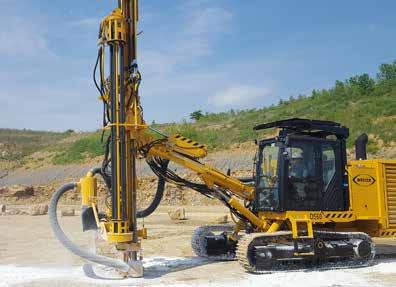
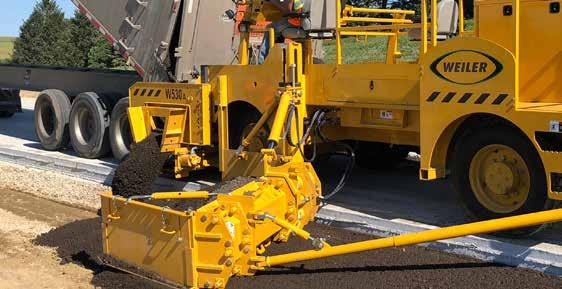
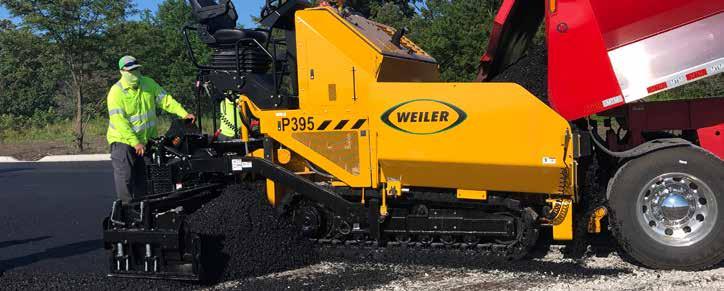

Perpetual Pavement Practices Convert Concrete Interstates in Illinois
Perpetual Pavement Practices Convert Concrete Interstates in Illinois
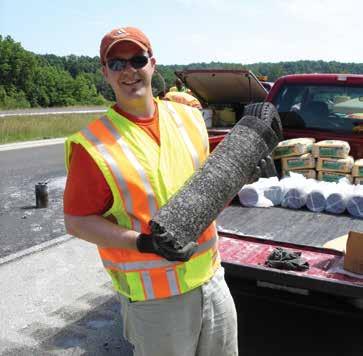 BY SARAH REDOHL
BY SARAH REDOHL
EEarlier this year, the Asphalt Pavement Alliance (APA) honored the first six recipients of APA’s newest Perpetual Pavement Award (PPA) category, PPA: By Conversion. Among the inaugural recipients of the PPA: By Conversion recognition was the Illinois Department of Transportation (IDOT) for a 9.5-mile HMA/rubblization project on Interstate 70 from milepost 136 to 146 in Clark County.
The four-lane award-winning section of I-70 was constructed by Howell Paving, Champaign Asphalt (now part of Open Road Paving Company LLC) and Howell Asphalt and opened to traffic in 2003.
“The project demonstrated to the Department that the perpetual pavement concept works and led to rubblization being adopted as a routine option for the Department,” said Kevin Burke, executive vice president of the Illinois Asphalt Pavement Association.
According to APA, IDOT has been an early adopter of the rubblization process. “The by-conversion was a first for Illinois and opened the door for this type of design,” said APA National Director Amy Miller.
IDOT ultimately decided to rubblize the existing concrete to provide a structural base and a drainage layer before being overlaid with a total of 17.5 inches of extended life hot mix asphalt (HMA) for a design life of 30 years.
“A significant reason [this design was selected] was that I-70 is a very busy route, especially with truck traffic,” said John Senger, engineer of pavement technology for IDOT. Today this section of I-70 sees roughly 25,400 vehicles per day with 52% truck traffic. “Before this project, we had never placed full depth HMA on such a high-volume truck route before, so it was kind of an experiment.”
According to Marshall Thompson, professor emeritus at University of Illinois’ Grainger College of Engineering, Illinois was “basically a concrete pavement state” at the outset of the interstate highway system. Thompson was an undergraduate student when the American Association of State Highway Officials (AASHO) Road Test in Ottawa, Illinois, was concluded in 1960. Throughout his six decade career, Thompson has seen Illinois change its approach.
“It wasn’t until 1989 that we began building full depth asphalt pavements,” Thompson said. “One of the issues IDOT was facing around the time the I-70 project was how to rehabilitate the original interstate concrete system.”
IDOT decided to perform a comparison across adjacent sections of I-70, including a control section with a standard mill and fill with 5 inch HMA overlay and a section with 12 inches of unbonded concrete overlay (UBOL) after milling to profile.
When tests were performed in 2018, the rubblized/HMA section had rutting of 0.11 inches, CRS of 8.0, and an IRI of 48. A CRS of 8.0 is not only well above the full-depth HMA model of around 5.6 and the CRCP model of around 6.9, but it is also better than the 7.7 achieved on
For the award-winning I-70 project, IDOT opted for a polymer in all lifts and a design of five lifts: two 5-inch lifts of N90 19.0 binder course with PG70-22, a 3-inch lift and a 2.5-inch lift with N105 19.0 binder course with PG76-28, capped with a 2-inch lift of N80 steel slag SMA 12.5 surface course with PG76-28 and a layer coefficient of 0.4.
the adjacent CRCP UBOL project. The IRI of 48 on the HMA section was also better than the UBOL section with an IRI of 75.
“The concrete sections out there have not performed as well as the asphalt overlays,” Thompson said. “I don’t think anyone would dispute that.”
“Overall, we’ve had excellent performance of HMA overlays on rubblized concrete in Illinois,” Thompson said. “And it’s very cost effective. When we get into extensive patching of our old concrete pavements, the costs are out of sight.”
To qualify for a PPA: By Conversion, the pavement must be an asphalt road constructed over an existing road that meets Perpetual Pavement criteria, demonstrate the quality and excellence APA expects from long-life asphalt pavements, and design criteria must be reviewed and approved by the National Center for Asphalt Technology.
RISE OF RUBBLIZATION
IDOT’s first rubblization/HMA overlay project was performed in 1996 on I-57 just south of Effingham, Thompson said. “By the time we got to the I-70 project, we had done quite a bit of rubblization from 1996 and 2003,” he said.

The original surface of that portion of I-70 was 8-inch CRCP constructed in 1971. Since then, the pavement received two asphalt overlays. After the contractor milled to remove the overlays, they broke the concrete pavement with an Antigo multihead breaker then ran it over with a Z-grid roller.
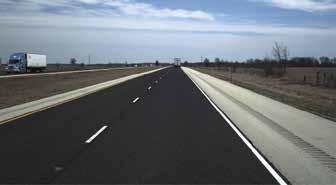
“We’ve had excellent success with rubblized concrete, particularly on interstates,” Thompson said. “We’ve done many miles of rubblized concrete on our interstates since and after looking at the performance of those sections, we’ve had no fatigue problems. Most of the distress has been environmental, so we can do a mill and fill and get the pavement back to 100%.”
“It was the success of the I-70 project that propelled the use of rubblization/HMA overlays on our interstates,” Senger said. “Now, we’ve done quite a few—especially on interstates where it’s very important to maintain traffic and not have large detours. Plus it allows us to turn the existing material into a very stable base while eliminating the durability/cracking problems with older concrete pavement. Once it’s rubblized, you can place a full depth HMA pavement on top of it and get a very successful life out of it.”
OVERLAY WITH HMA


However, rubblization is only one part of the equation. The HMA overlay is another. In order for a pavement to be considered an extended life HMA, IDOT requires one or more of the following elements: SMA surface; polymer used in all lifts; 1% hydrated lime (dry) anti-strip in all lifts; polymer tack coat between lifts; extra tack coat on longitudinal joints, which has been replaced with a VRAM since the I-70 project’s construction; material transfer vehicle use on all lifts; and/or no rich bottom layer base.
For the award-winning I-70 project, IDOT opted for a polymer in all lifts and a design of five lifts: two 5-inch lifts of N90 19.0 binder course with PG70-22 (183,301 tons total), a 3-inch lift and a 2.5-inch lift with N105 19.0 binder course with PG7628 (93,141 tons), capped with a 2-inch lift of N80 steel slag SMA 12.5 surface course with PG76-28 and a layer coefficient of 0.4 (42,239 tons).
“This project has held up so well specifically because it’s 17.5 inches thick and there’s polymer through all the lifts,” Senger






The job required 183,301 tons of N90 19.0 binder course with PG70-22, 93,141 tons of N105 19.0 binder course with PG76-28 and 42,239 tons of of N80 steel slag SMA 12.5 surface course with PG76-28.
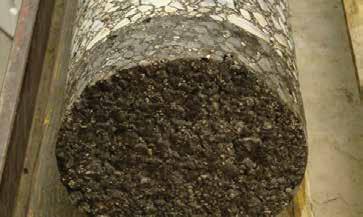
said. “We’ve also seen really good performance from SMA asphalt. The higher binder content really helps with oxidation and aging. Last time I drove this route, the surface was still black like the day it was paved.”
According to Thompson, IDOT had been investigating the idea of making HMA pavements last longer under the concept of long-life pavements since the 1990s. By the time this portion of I-70 was paved, that had evolved into the concept of perpetual pavements.
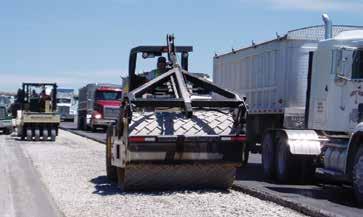

“Early on, we used a typical fatigue-driven approach where the more traffic you have, the thicker pavement you get,” Thompson said, adding that IDOT has utilized mechanistic-empirical design for full-depth asphalt pavements since 1989. “The traffic numbers for I-70 were very high, so that section is fairly significant in terms of thickness.”
“This project provided us with confirming data that thicker pavements last a longer time,” Thompson said. However, Thompson said it was the superior performance of this section of I-70 that indicated IDOT’s fatigue algorithm approach was too conservative for high-traffic volume pavements. Ultimately, the project helped shape IDOT’s approach to the perpetual pavement concept while also reducing thickness.
“We learned a lot from that project,” Thompson said. “We are still conservative, but not as conservative as we were before.”
THIN TO WIN
According to Senger, the I-70 project was designed before IDOT performed pavement life cycle cost analyses for all its pavements. Now,
After the contractor milled to remove the overlays, they broke the concrete pavement with an Antigo multi-head breaker then ran it over with a Z-grid roller.
IDOT must perform this analysis on any new pavement more than 4,750 square yards. “The option with lower life cycle cost will win the bid as long as it’s more than 10% below the other option,” he said.
“Thickness plays a huge role in what that costs over the pavement’s lifetime,” Senger said. “In order to keep HMA as competitive as possible, it's best for us to opt for thinner HMA pavements without sacrificing performance.”
“In 2003, we were still using our initial fatigue algorithm, which was very conservative and contributed to the thickness of that pavement,” Thompson said. “Sam Carpenter on our U of I staff did a lot of fatigue work with various Illinois mixes and his results suggested these overlays were performing better than our algorithm predicted.”
In 2010, IDOT made adjustments to its mechanistic-empirical pavement design to include a fatigue endurance limit (limiting strain criterion) of 70 microstrain for the bottom binder layer, which reduced the overall thickness of HMA. “That’s led us to a 16.5-inch upper limit for full-depth HMA,” Senger said. For HMA overlays over rubblized concrete pavements, Thompson said IDOT’s upper limit is 11.75 inches. If the I-70 project occurred today, the overlay would be 11.25 inches thick.
“Based on the data we’ve developed over the years, we’ve got HMA overlays on rubblized concrete [interstates] as thin as 8 inches,” Thompson said. “We even have an experimental section of I-57 near Effingham with a 6-inch overlay that’s been performing quite well.”
“Typically everyone winds up being on the conservative side with perpetual pavement designs because you’d rather the pavement last longer than not last long enough,” Thompson said. “But within the perpetual pavement concept, we’re reducing the thickness and they’re still doing quite well.”
“Essentially, what we’re trying to do is to balance being conservative with keeping HMA competitive so we can get the best possible pavements as possible,” Senger added.

DECADES OF PERFORMANCE
Nearly 20 years after the HMA overlay was placed on I-70, it is still performing quite well.
“We don’t see too many HMA pavements last this long with such little maintenance,” Senger said. “It’s probably getting to the point where the district needs to seal this up to stop further oxidation and water intrusion, but structurally this is performing really well and we think it will for the foreseeable future.”
The most prevalent issue on the project is some centerline distress, Senger said. “That happens with all the older pavements,” he added. “However, we have some new processes in place to hopefully take care of that.”

Since the I-70 project was completed in 2003, IDOT has made great strides in reducing centerline distress through the implementation of longitudinal joint sealant (LJS). “We did five experimental projects with LJS and fully implemented that in 2016 so all our new asphalt pavements and overlays use LJS,” Senger said. “Now that we can get a joint to last 15 to 20 years with LJS, we can get that surface to last much longer before we need to do major rehabilitation.” He expects in the next five or so years that the award-winning portion of I-70 will require a mill and fill, and when that’s done, it’ll be done with LJS.
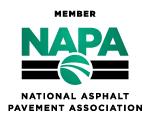
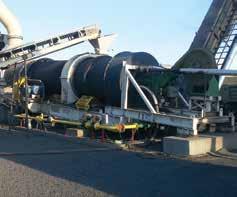
That’s the way IDOT is moving forward with perpetual pavements. “Over time, we’re identifying and tackling a lot of the weaknesses of our HMA designs,” Senger said. “Our mechanistic designs these days are often getting us into the perpetual pavement design timeframe.”
PERFORMANCE, GUARANTEED
Not only was the I-70 project a perpetual pavement, but it was also the first warranty project IDOT let. Mandated by Illinois FIRST legislation of 1999, IDOT implemented a five-year performance warranty on the project. “The asphalt industry advocated for a 20-year warranty because the industry was confident in the future performance,” Burke said.
The legislation also required extended life designs, which aim to achieve a 30-year life cycle without requiring major rehabilitation or patching other than surface replacement at some frequency. Ultimately, there were no warranty repairs on the pavement, though some were required on the bridge decks.
“The warranty probably played a role in the contractor's performance on it, but we can attribute the success of this project to a lot of different areas beyond the warranty,” Senger said. For example, the location in the southern part of the state where there’s less freeze-thaw and fewer snow plows, the polymer in every lift of asphalt, the use of SMA for the top lift and the thickness in general.

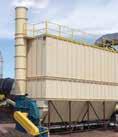
“We didn’t really hold anything back on this project,” Senger said. “We gave it every chance we could to succeed, and it’s done that and more.”

READ YOUR TBTS FOR PRODUCTION, TOO READ YOUR TBTS FOR PRODUCTION, TOO
BY SANDY LENDERMMany readers of AsphaltPro Magazine may already be signed up to receive the weekly Toolbox Tip email we send out on Sunday nights. The free, two-minute-read content is designed to assist middle management, foremen, supervisors, safety directors, and others in similar roles in your company with tailgate talks, safety meetings, and quick bottom-line improvements around any asphalt-related job site.
The quick weekly tips usually focus on paving, pavement maintenance, pavement preservation, QC/QA and equipment maintenance activities because, as the name implies, they’re geared to the folks in the field who seek toolbox talk fodder.
Quite often, the tips hit plant production and lab specifics. For the month of January, while the print and digital versions of AsphaltPro Magazine are focused on plant production, the tips will also speak directly to the plant manager, plant operator and plant maintenance personnel who are preparing for stack testing.
For example, counterflow drum technology lends itself to gathering production gases— no matter the fuel or temperature used—and moving those gases back into the combustion area for annihilation. AsphaltPro Magazine staff is not positioned to pick and choose which counterflow drum or flight arrangement will offer the greatest return on investment when it comes to knocking those gases down, but we can share facts from industry experts every week.
LEARN MORE
CO2 = carbon dioxide
HAPs = hazardous air pollutants
GCAPs = gaseous criteria air pollutants
PM = particulate matter
NOx = nitrogen oxides
SOx = sulfur oxides
VOC = volatile organic compound
Let’s start right here with Mike Devine of Asphalt Drum Mixers Inc., Huntertown, Indiana. He shared that his company’s ADM EX Series plants feature single-drum counterflow technology with separate drying and mixing zones for the purpose of achieving high levels of heat transfer and fuel efficiency, and long aggregate drying and mixing times for high quality asphalt production. He explained for readers, “Counterflow technology captures residual gases and reintroduces them back to the combustion zone, practically eliminating blue smoke and hydrocarbon emissions to meet strict environmental regulations.”
The Toolbox Tips during January will help asphalt producers think of ideas for getting plant componentry running as efficiently as possible—no matter which technologies are involved—in preparation for stack testing.
A quick note for original equipment manufacturers (OEMs) and service providers out there: If you would like to write any production, paving or testing tip that is useful to our readers, you are welcome to send it to sandy@theasphaltpro.com for review. We want to share best practices with the industry but reserve the right to edit tips to make sure they’re not overly promotional in nature. As you can tell by this brief article, the point of the Toolbox Tips from AsphaltPro Magazine is to educate and help folks in the field. We encourage and invite our partners to be involved in that education while upholding the high level of integrity our editorial enjoys.
This is an example of single-drum counterflow technology available in the EX Series plants from ADM. Photo courtesy of ADM
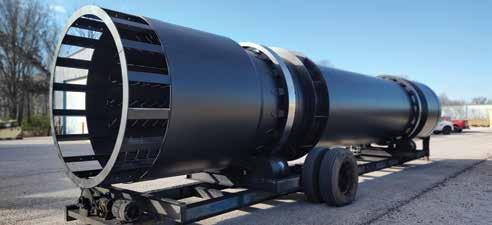
WEB EXTRA
Sign up for the free, weekly Toolbox Tip email at this link: theasphaltpro.com/upgradedaily-toolbox-talks/
For over a decade, AsphaltPro Magazine has been providing this free, weekly, digital content to anyone who wants it. If you’re a contractor, producer, equipment operator, supervisor, lab tech or manager in the field, you’ll receive your email Sunday evening to start off Monday on a positive, informative note. If you’re a consultant, OEM, salesperson or other person affiliated with the industry, you’ll receive your email Monday morning when you get to your office.






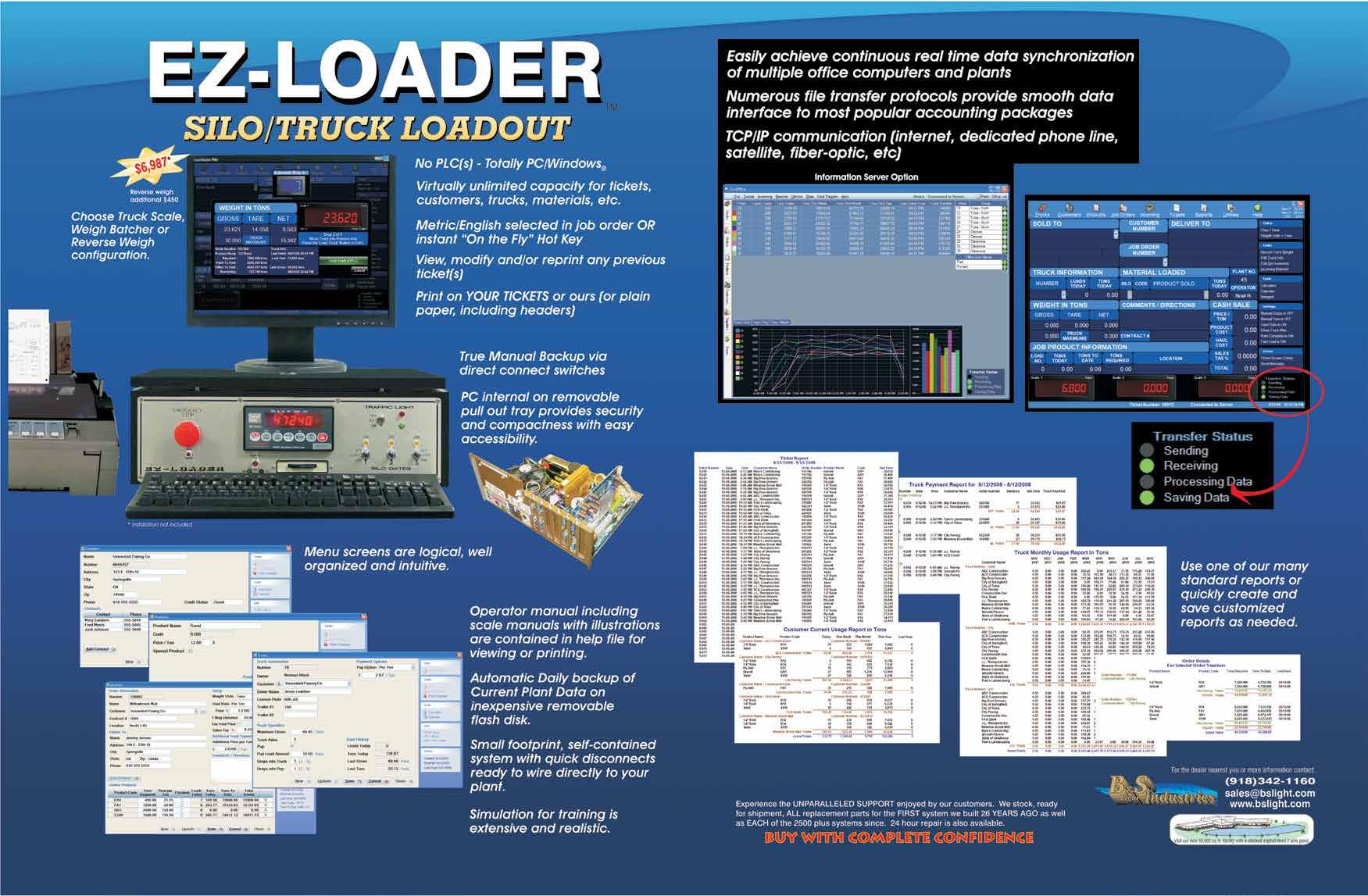

Meet NAPA’s Incoming Chairman Christian Zimmermann
BY ASPHALTPRO STAFFThe AsphaltPro staff continues the annual tradition of introducing the incoming chairman of the National Asphalt Pavement Association (NAPA) with 2023 Chairman Christian Zimmermann, who serves as the president of the New England Group for CRH Americas Northeast Division, Belmont, New Hampshire.
In 1986, CRH became a member of NAPA. Zimmermann shared that membership in NAPA benefits the branches of CRH Americas Materials because the association supports the whole asphalt pavement industry through leadership and advocacy around funding, plant operations, sustainability, worker health and safety, asphalt mix designs, and defending market share. For him personally, membership in NAPA means being a part of something that accomplishes much for our industry through engagement with its membership and a top-notch association staff.
Before he takes the stage at the NAPA annual meeting in Miami, Feb. 6, to address the membership, Zimmermann took the time to share some thoughts with the industry at large. He brings not only a degree in civil engineering to the table, but he also brings 45 years of experience in the asphalt industry, as well as a spirit of adventure and an understanding of the importance of partnering and encouraging one another.
Christian Zimmermann, the president of the New England Group for CRH Americas Northeast Division, will serve as the 2023 NAPA chairman of the board.

You’ve been active on NAPA committees devoted to highway bills, infrastructure reauthorization, and so on. Could you share what motivates you both personally and professionally in this arena? When 65% of your company’s revenue stream comes through public funding—federal, state, and local—being politically active and lobbying for highway bills is our industry’s most important marketing effort.
How did you join the asphalt industry? My stepfather was Milo Pike, who sold Pike Industries to CRH in 1988, so I started working for Pike during the summers in the late ’70s when I was in high school. I got to learn all the different jobs related to road building including working on a paving crew for a stint. I also did black sealer work, bridge membrane, fencing, heavy highway cuts/fills, and placement/fine grading of select materials.
Could you share with readers how your education encouraged or fed your interest in the asphalt industry? Although I majored in civil engineering, I always knew I wanted to be on the other side of the fence—building roads and bridges vs. designing them. Being outside and working with big equipment was far more interesting to me than sitting behind a desk at a computer, which is my job now! Getting a degree helped me to understand what goes into a design so that I could better work/collaborate with the design engineers on field changes and proposing lower cost approaches through value engineering.
What is your favorite method for recruiting new asphalt professionals to the industry in general? You get to work outside; you get to build stuff that is tangible and important to our society; you get to work with big Tonka toys; the people who work in this industry are salt-of-the-earth types who like to work hard and take pride in what they do. It’s fun being around them. And we all share in success (and failure). It’s never a zero-sum game, which I would not do well with. We are in it together.
What top two or three pieces of advice would you offer to members of our industry for getting the positive environmental message of asphalt in front of their local and state representatives? Most legislators do not understand our industry and many think of it as being “dirty.” It’s important to bring them out to our facilities and show them what we do to protect the environment and how we are working toward net zero emissions through things like recycling (RAP, RAS, plastics, rubber), construction of perpetual pavements, lowering moisture content in our aggregates, and lowering mixing temperatures using warm mix technology. Our industry needs to continue to educate lawmakers that the asphalt pavement industry is the largest recycler in the world, and we can do even more by working with DOTs to increase allowable RAP usage. We also are beginning to research alternative binders. Our industry is progressive.
On a scale of 1 to 5 (1 being none at all), how much of a threat to the asphalt industry’s market share is the concrete industry today? On what do you base that ranking? 3—Asphalt pavements have proven themselves to be the material of choice for roadway pavement structures due to their flexibility, smoothness, quietness, speed of construction, recycling capabilities, and overall cradle-to-grave life cycle costs. The concrete industry cannot compete on these most important merits.
On a scale of 1 to 5 (1 being none at all), how much of a threat to the asphalt industry’s market share are the “Buy Clean” policies being bandied about in different state legislatures? 3—Asphalt has a great story to tell regarding sustainability (circularity through recycling as an example) but my concern is how agencies will measure being “clean.” How can we keep pavement selection (and perhaps producer selection) to be purely objective, fair, and easy to measure/understand?
What are your top two or three ideas for helping the asphalt industry deliver correct information about our product to lawmakers who are introducing bills concerning “buy clean” policies and construction materials selection at the state level? Agree on the baseline. Determine what
we are comparing to so we can define “clean.” Ensure state DOTs are not working against us through their specifications (i.e., limiting RAP use). Develop EPDs and spend the time to learn what levers can be pulled to reduce greenhouse gas emissions so we can speak intelligently about our product and its impact on the environment.
What other threats to the asphalt industry do you have on your radar to guard against during your year as chairman? I think the biggest threat to our industry is lack of engagement by its members. Thinking that someone else will take care of “it” is a recipe for disaster.
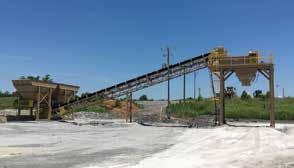
How can readers of AsphaltPro assist you in your chairmanship goals for 2023? Get involved! Attend the NAPA annual meeting; go to DC for the TCC Fly-In; host a legislator at your HMA plant; put together EPDs for your mixes and get educated on emissions.
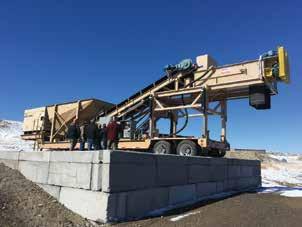
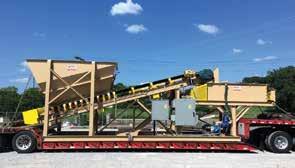
As you take on the travel and engagements of a NAPA chairman, who will assist with your many responsibilities back at CRH Americas? I am president of the New England Region for CRH Americas Materials. There are three OpCo presidents who work directly for me, and all are very capable and experienced. I have 100% confidence in their abilities, which will free me up to dedicate the time needed to be effective in my NAPA chairmanship. I also have very accommodating bosses at CRH AMAT who very much support NAPA’s work and make it a priority for CRH employees to be actively involved.
GET-TO-KNOW CHRISTIAN ZIMMERMANN

What do you see as the most important part of your job as the 2023 chairman for NAPA? Educate, motivate, influence industry to participate and engage
What do you find most enjoyable about being a leader in your company, and how do you expect that experience will influence your activities as 2023 chairman of NAPA? Getting to know people and learning from them; the NAPA chairmanship will certainly afford me more opportunities to network and hear a variety of perspectives!
“I was part of a panel in 2009 that included then Vice President Joe Biden promoting the positive impacts of the 2008 stimulus package that contained $30 billion for highways,” Zimmermann shared. “I was president of Pike Industries at the time and the stimulus created more than 50 new jobs at Pike alone.”

There’s always a way to combine fundraising for a good cause with enjoying outdoor activities.

Could you share with readers your immediate family? My mother, Penny Pitou, won two silver medals in the 1960 Olympics in Alpine Skiing (Downhill and Giant Slalom). She turned 84 in October. My father passed away in 2016—he was also an Olympic Alpine Skier from Austria. My wife, Deb, and I have been married for 29 years and have two children. Zane is 22 and a senior at The University of Utah. He loves the outdoors and is majoring in film production. My daughter Zoe is 20 and goes to Dartmouth College. She is on the United States National Alpine Ski Team and competes in Europe much of the winter. She is a more “non-traditional” student.
Could you share with our readers an example of a challenge you’ve overcome in the past and how you overcame it (whether business or personal)? My wife and I did a lot of rock climbing before we had kids. When I was a project manager back in the ’90s I would take 8-10 weeks off in the winter and Deb and I would travel the world rock climbing. I remember when we were in Alicante, Spain, and there was this very intimidating climb that was remote—like an hour hike in, that nobody but climbers know about. The climb started out over the ocean—you had to traverse out about 100 feet to the start. We got to the belay, and I started up this slightly overhanging crack that seemed hard. I wasn’t feeling it, so we eventually backed off. A few days later, we met up with some friends from another climbing area (who were both really good) and they offered to come back out with us. We returned and with their encouragement and my feeling of being “safe,” I made my way up the 200-foot crack feeling strong and “in the zone.” Moral of the story? It’s not shameful to “back off” something and return to it another time when you are more ready.

And our friends climbed this crazy hard arete (an edge pointing out from the rock wall) another 100 feet out over the raging ocean with little to no protection.
What volunteer work do you make time for/encourage others to consider and why? You can probably imagine that my volunteer work has been around sports. While I have begun to pass on the torch, I started a soccer league in our area, and it grew to more than 150 kids. My buddy and I couldn’t stand watching the recreation league play and there was no higher-level soccer, so we started a league that certainly filled a need in our community.
What other hobbies offer you work/life balance? Skiing, hiking, rock climbing, mountain biking, and I used to do a lot of windsurfing but am now learning how to kite surf.
Could you share a quote that you find inspiring or motivating? For building roads, from my early mentors: “The three most important things when building a road are drainage, drainage, and drainage!” For life, the Lou Holtz quote: “Do what’s right, do your best, treat others as you want to be treated.”
Who is a person who has served as a mentor for you, and what traits do you feel others can emulate from him/her to grow in their careers, lives, or service to our industry? I have had a number of mentors and my biggest learnings have been around taking initiative, commitment, teamwork, follow through, and being someone others can count on to get things done. Of course, caring, passion, being a good listener, and being humble are all very important traits for leaders.
“I THINK THE BIGGEST THREAT TO OUR INDUSTRY IS LACK OF ENGAGEMENT BY ITS MEMBERS.”—CHRISTIAN ZIMMERMANNChristian and Deb Zimmermann enjoy outdoor activities together.
STRENGTH IN FAMILY

Christian Zimmermann shared that his biggest lessons in life have centered around teamwork and being someone others can depend upon, among other good, positive attributes. His family is core in his strength.


Taking place at BOTH:
LEFT: Patriarch Ergon Zimmermann was an Olympic Alpine Skier from Austria. RIGHT: Matriarch Penny Pitou was an Olympic Alpine Skier who won two silver medals in the 1960 Olympics.



Diversity and inclusion are key to our future sustainability as an industry. This session will discuss management efforts to recruit, retain, and promote women into the asphalt industry. A panel of industry leaders will address the importance of attracting qualified women and addressing the needs of women to keep them in the industry, while developing a culture of inclusivity.
womenofasphalt.org
Start Your Paving Wish List Here
BY ASPHALTPRO STAFFThis month’s product gallery focuses on paving and pavement maintenance products and services. As you perform winter maintenance tasks, don’t forget to do a little snow-bound dreaming of what you’d like to add to the 2023 fleet. These OEMs and providers are ready to help you. When you reach out to them, make sure they know you saw them in AsphaltPro Magazine.
"Patterned Screed Plate, Smooth Mat” article in the March/April 2021 issue. Screed cast plates are made with high strength chromium carbide, delivering high wear resistance. A new way to secure the plate to the screed, the Bullox system reduces screed plate change time up 80%, according to the manufacturer.
The Axenox® screed system will be exclusively available for Cat customers and supported by the extensive Cat dealer network.
COLORBIOTICS
Jim Weber, owner of Ohio Mulch Supply Inc., Columbus, Ohio, has been a customer of Colorbiotics’ mulch colorants and machinery for years. When it was time to upgrade the headquarters’ parking lot from gravel to pavement, Colorbiotics had another solution for him.
Patcher 4 offers a material tank double that of the Patcher 2 model. The first Patcher was introduced to the market simultaneously with Mastic One, Matrix and TechCrete to repair wide cracks and distresses in bituminous and PCC pavements. The Patcher 4 is now available for pre-order and has a delivery date in early 2023.
EARTEC
BOMAG
BOMAG Americas, Ridgeway, South Carolina, announces it has signed All Roads Equipment as a new dealer for its specialty equipment lines, covering all counties in Virginia. Under the new collaboration agreement, All Roads Equipment, a division of All Roads, will provide contractors in the region with sales, service and parts support for BOMAG’s extensive landfill and embankment compactor, cold planer, and recycler & stabilizer equipment lines.
For more information, visit www.bomag. com/us-en
CATERPILLAR
Caterpillar Inc. announces the company has entered into an agreement with construction solutions supplier, Axenox Inc., to acquire the intellectual properties of two of the company’s asphalt paving screed products. Under the agreement, Oxclaw® textured screed plates and Bullox® modular screed plate system will be available options exclusively for Cat® asphalt paving customers.
Oxclaw’s three-dimensional textured screed provides lateral compaction confinement to asphalt material, as described in the
“The purpose of this project was to pave the lot so we can properly store pallets and our products on the hard top,” Weber explained. “We did not want the gravel to continue to jump up and lay on the pallets when we moved them across the lot.”
Instead of paving the lot as a traditional blacktop, the team at Ohio Mulch Supply was able to use Biomag Easy Pave to achieve similar results at a fraction of the cost. Skilled trade workers loosened around 2 to 3 inches of the gravel onsite and then sprayed the Easy Pave topical solution on the surface. The entire application took one day, with full results within two weeks.
“The product hardened the surface, preventing rainwater from softening up the lot area. Plus, it’s much less expensive than a traditional blacktop,” Weber said. “It has also eliminated the concern for the dust that was kicking up before, which is an additional benefit.”
The soy-based formula of Biomag Easy Pave provided him additional peace of mind. “That certainly takes away any guesswork from us as far as worrying about getting a permit to spray,” Weber said.
For more information, visit https:// invigorateasphalt.com/biomag//
CRAFCO
Crafco Inc., Chandler, Arizona, introduces its new, larger capacity Mastic Patcher. The
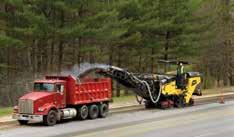
Eartec EVADE, from Eartec Co., Narragansett, Rhode Island, are a new class of light industrial, full duplex headsets designed for professional crews that need hands free, simultaneous talk, wireless communication. Single and dual ear EVADE feature deluxe padding and a fully adjustable headband for comfort. The Evade XTreme is a heavy duty, dual ear model that can be worn with a hard hat. EVADE headsets are self-contained and feature a compact full duplex transceiver built inside the ear cups, eliminating wires and belt packs. Complete intercoms include one “main” unit that relays the digital signals generated by up to eight “remotes.” The headsets link automatically without a hub or base station. Evade wireless can connect up to nine users within a 400-yard range.
EARTHWAVE
As paving contractors and heavy construction contractors increasingly adopt technology to operate more efficiently, FleetWatcher, Indianapolis, offers integrations to offer a flow of data to further enhance the functionality of programs like Viewpoint, B2W, OnStation and many more.
Data from e-ticketing, cycle counts, tonnage and more automatically flows from FleetWatcher’s Materials Management Solution (MMS) into the appropriate areas within the software programs. With the FleetWatcher Construction Management Solution (CMS), information like hour meter readings, location, job assignment and equipment-move information is available for import. Additionally, data can be imported into FleetWatcher from Vista, such as project and equipment information.
For more information, call (800) 553-0027.
INNOVATION EAGLE
There’s always something new at Eagle Crusher. Eagle Crusher consistently leads the industry in new product innovations and 2023 will be no exception. Join us at CONEXPO-CON/AGG, and see our newest equipment and technologies on display, including the UltraMax®1600X-OC Portable Impactor Plant and the 8x20 Screen Plant with Integrated Feed Conveyor and Blending Gates.

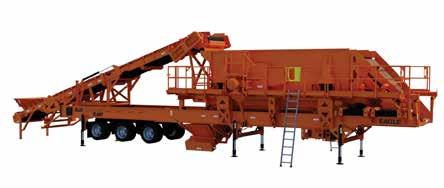

Learn about the many plant options for asphalt producers from our expert personnel in the booth. Outstanding plant options include onsite RAP systems for crushing and precise screening, allowing product consistency with a minimum of white rock and a minimum of fines. Also available are highly portable plant options for larger-sized jobs with high volumes of material at- or near-spec, allowing most to be removed before crushing to increase overall production and reduce wear.
GSSI
Geophysical Survey Systems Inc. (GSSI), highlights its PaveScan® RDM 2.0, a second-generation asphalt density assessment tool ideal for non-destructive asphalt compaction testing, quality assurance/quality control of new pavements, and determining pavement non-conformity. By uncovering inconsistencies that occur during the paving process, including poor uniformity and significant variations in density, PaveScan RDM 2.0 helps to avoid premature failures like road raveling, cracking, and deterioration along joints. The pavement density measurement technology used in PaveScan RDM 2.0 is an accepted American Association of State and Highway Transportation Officials (AASHTO) specification, PP 98-19.
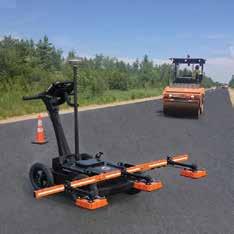
For more information, visit https://www. geophysical.com/products/pavescan-rdm.
RENEWABLE LUBRICANTS
Renewable Lubricants, Hartville, Ohio, presents patented, Bio-E.P.™ Gear Oils, which are designed for lubricating spur, helical, bevel, and worm gears subject to heavy loading or shock loading in heavy-duty applications. These environmentally friendly formulations meet or exceed the U.S. Steel 224, AGMA 9005-E02, DIN 51517 Part 3, ISO 12925-1 CKD, David Brown DB S1.53.101 and Cincinnati Machine performance requirements, according to the manufacturer.
These bio-based products are designed to help companies achieve their sustainability goals. Formulated from renewable agricultural bio-based resources, they are non-tox-
ic, zinc-free formulations that contain no heavy metals.
SURFACE TECH
The DFNDR is the latest evolution of a line of dosing systems offered by Surface Tech, San Diego. This model is fully encased, easy to set up and run, and fully automatic, according to the company. The redesigned and enclosed system is compact and allows for set-up anywhere in an asphalt plant. Producers will find it most useful when housed and set up permanently with a 120V power source and a steady 110 psi air supply, according to the company.
A programmable logic controller (PLC) continually measures the weight of any Surface Tech aramid product and/or length fed through the hopper and compares it to a desired target rate based on the plant’s production needs. Constant measuring ensures a consistent, uniform feed of the Surface Tech aramid into the mix. The company reports that producers will have no flyaway mess to deal with, and they’ll achieve a mix that contains the precise amount of 2.1 ounces of aramid per ton with no clumping.
“We have devoted many hours of study, field trials, and engineering to bring the DFNDR to the highest level of automation and accuracy available. It offers a dosing technology that asphalt producers can rely on with confidence,” said Steve Santa Cruz, President of Surface Tech. The DFNDR meets ISO 9001:2015 standards and is UL Listed. It’s made in the USA by HIS Innovations Group. Surface Tech provides training and support to ensure each job meets the desired specifications.

For more information, visit https:// surface-tech.com/solutions/
TAKEUCHI
The first compact track loaders rolled off the assembly line at Takeuchi’s new manufacturing facility in Moore, South Carolina, in September. This facility, Takeuchi’s first production facility in North America, will eventually produce nearly all the company’s compact track loaders, allowing Takeuchi to reduce compact track loader production lead time for its North American customers and better meet market needs worldwide. Takeuchi has historically produced compact track loaders at one of their factories in the Nagano province of Japan.
Forty people currently work at the new 156,000-square-foot production facility and standalone office building, with plans for additional staff to come on board as Takeuchi ramps up track loader production over the next few months. Ultimately, the facility will employ around 150 people, generating even more job opportunities and infusing money into the local economy.
WIRTGEN
Wirtgen Group introduced the AutoTrac for the WR series cold recyclers and soil stabilizers during BAUMA 2022. By enabling precise, automatic steering, the AutoTrac system helps Wirtgen wheeled recyclers to achieve greater process efficiency and, as a result of this, a high degree of environmental compatibility, according to the manufacturer. The product steers the machine precisely within tolerances reckoned in centimeters on the basis of a previously calculated reference strip and a specified overlap of adjacent strips. AutoTrac relies, among other things, on various global navigation satellite systems (GNSS) for precise determination of the machine’s position and direction of travel. The system is operated from an additional control panel that also enables the operator to view information about the position of the machine and previously completed strips. Keeping to the pre-set overlaps reduces the consumption of binding agents, consumables and fuel, makes the carbon footprint smaller and shortens the project completion time. The outcome of this is increased process efficiency and, in consequence, greater cost-effectiveness and environmental compatibility.
For more information, visit www.wirtgengroup.com.
The new Wirtgen AutoTrac system for the WR series can conserve resources and increase efficiency.
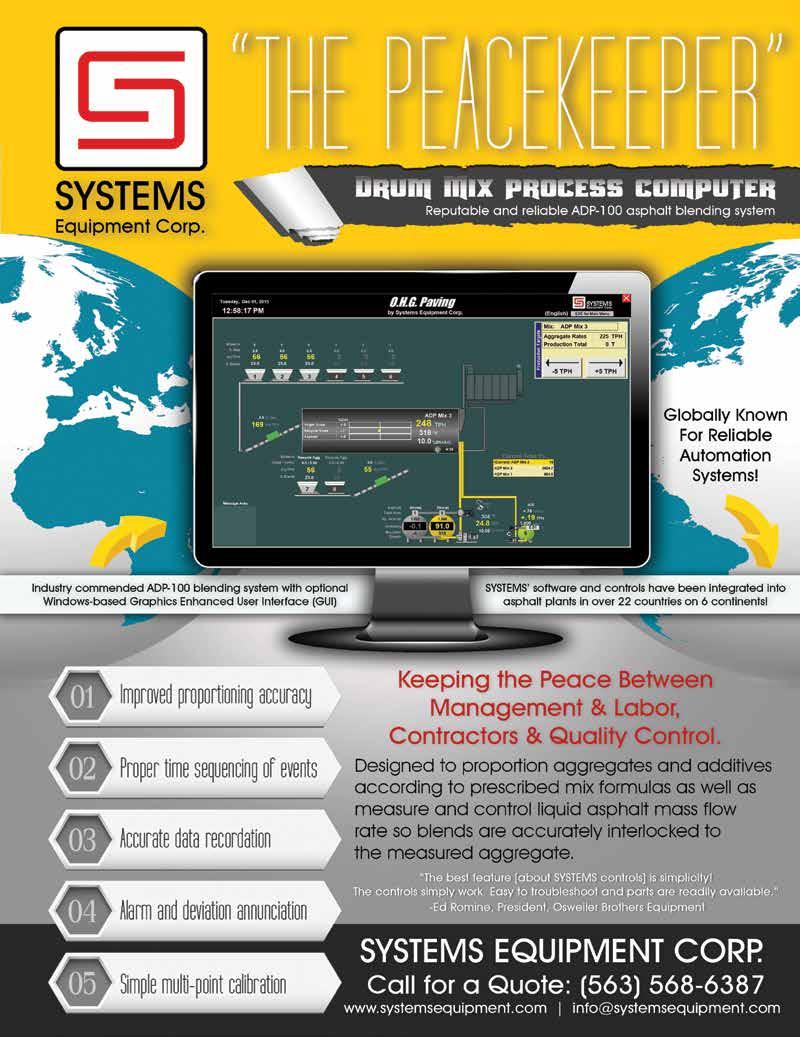
Get Industry Training, Information in Person
BY ASPHALTPRO STAFFDuring the first quarter of the New Year, asphalt company training directors, managers and owners will have the chance to load up on knowledge in real life. While the following big four events aren’t an exhaustive list of the programs available to the asphalt industry, they are programs you’ve seen advertised in AsphaltPro magazine. We’d like to share some highlights you may or may not remember about these opportunities. Take a look, in calendar-event order.
NPE
Jan. 25-27
Charlotte Convention Center nationalpavementexpo.com/ The National Pavement Expo and Conference takes place annually. This year, AsphaltPro Magazine invites you to stop by Booth 1726 in Charlotte, North Carolina, to visit with us. We’ll have paving consultant John Ball in the booth for our popular “Ask the Expert” live series.
The Women of Asphalt (WofA) also have live events happening at Booth 335. That organization is not only hosting a session during the conference— “Women in the Workforce: Recruit, Retain, and Promote,” Thursday, Jan. 26, 8:30-10 a.m.—but they will also host the panelists at the booth. The industry experts available to discuss workforce development with you include: Paul Battista, founder and CEO of Brothers National; Latrell Cates, HR business partner and EEO of Reeves Construction Company; Mary Katherine Harbin, vice president Foothills Division of Maymead Inc.; Ashly Rieman, project manager of Milestone Contractors; and Victoria Taffet, corporate social responsibility director for Colas USA.
Workforce development is only one aspect of the programming the convention planners are pleased to share. A spokesperson for Emerald, the event owner, explained: “This year’s conference program incorporates 60+ sessions and workshops presented by industry veterans in both the residential and commercial sectors, professional engineers, upand-coming leaders, street superintendents, and business and marketing gurus. These di-
verse perspectives offer attendees the opportunity to learn not only about their specific areas of work, but also allow for continued growth and exposure to new avenues they can expand their business offerings to include. From retention and recruitment strategies, sealcoating mix design and materials, and technology and teamwork, the NPE 2023 Conference has highly valuable educational content for professionals at every stage of their career.”
Beyond the conference schedule, attendees are encouraged to check out the tradeshow floor and this year’s new Driveway Games.

“One of the most important aspects of the show this year and in years past is the exchange of knowledge during the National Pavement Expo,” the spokesperson shared. “Everyone in attendance is excited to share ideas, lend their feedback and create business relationships that expand beyond just the 3.5 days at National Pavement Expo. The mentorship and collaboration of small to medium sized contractors, municipalities and subject matter experts is something that makes the National Pavement Expo truly unique.
“We also have some excellent new additions at the show this year, including the 1st Annual Driveway Games, which offers some friendly competition and fun with adult big wheels racing, basketball, corn hole and more; as well as our Session Stage area that will host multiple speaker meetand-greets and breakout sessions. The good times don’t stop there—on the evening of Thursday, Jan. 26, NPE 2023 will be heading over to the NASCAR Hall of Fame for our private party, exclusive to NPE exhibitors and attendees only.”
NAPA ANNUAL MEETING
Feb. 5-8
Loews Miami Beach Hotel www.asphaltpavement.org/ programs/napa-events/napaannual-meeting
From the golf tournament on Saturday to the inspirational keynote address from recently retired Olympic gold and bronze medal‐winning alpine ski racer Lindsey Vonn to the Sheldon G. Hayes awards ceremony
The 2023 National Pavement Expo Hall brings together a variety of the industry’s top manufacturers and suppliers to present the latest trends in paving and pavement maintenance, asphalt design, technology and software, and machinery—just to name a few! Having this wide array of exhibitors gives NPE attendees the ability to network with their peers and make new connections, discover innovative products and services, and learn about trends and the newest technologies in the industry. Attendees can get early access to the Expo Hall during Preview Night on the evening of Wednesday, January 25. The image above is from 2022, courtesy of Emerald.
breakfast, asphalt industry members have ample opportunity to rub elbows with peers and colleagues at the 2023 National Asphalt Pavement Association annual meeting in Miami Beach.
The national association has put together a series of breakout sessions for brainstorming best practices for reducing emissions and saving money in your operations, recruiting and retaining the modern workforce, asphalt plant technology, asphalt’s advantage in a changing competitive landscape and lessons learned during asphalt plant zoning in between national committee meetings.
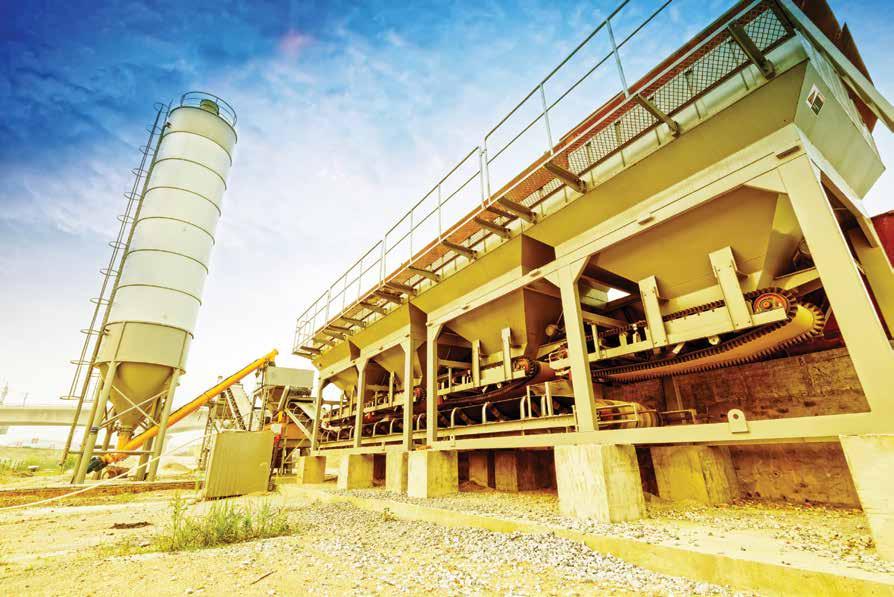
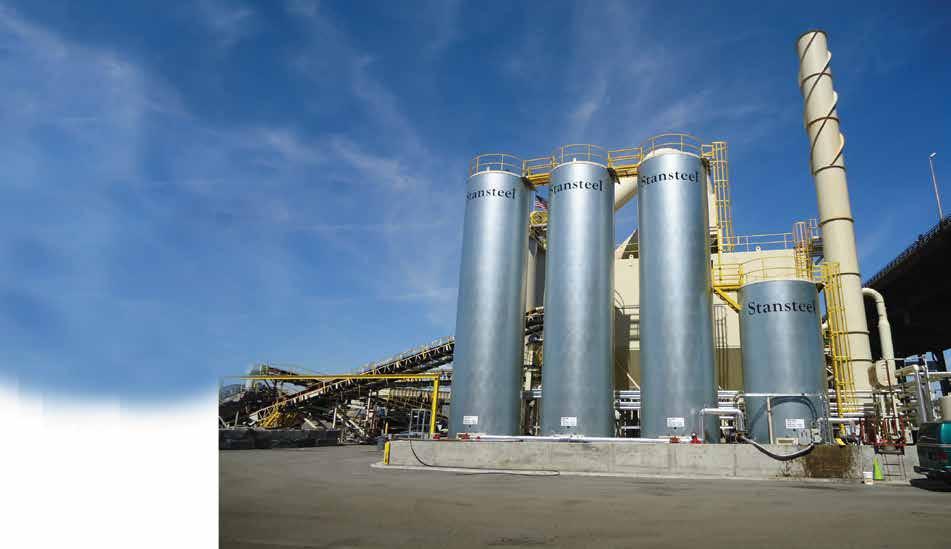
RMACES 50TH ANNIVERSARY
Feb. 7-8
National Western Complex, Denver rmaces.org/
This year’s Rocky Mountain Asphalt Conference & Equipment Show is a special one as the Colorado Asphalt Pavement Association (CAPA) celebrates its golden anniversary. The state show typically attracts
over 1,000 attendees. When combined with speakers, exhibitors and volunteers, they host an event of over 1,300 people every February in Denver, with additional pomp and circumstance at the annual “Best in Colorado” awards banquet.
The RMACES website shares the show’s history, starting in the early 1970s: “In early 1973, Charlie Owen, regional engineer
from the Asphalt Institute of Chicago, contacted Walt Howat from the Asphalt Institute of Denver, to organize a seminar for the Western Mountain State Region.” The story goes, Howat contacted various asphalt industry representatives in the area to serve on an organizing committee and they developed a program for the first Asphalt Pavement Seminar. The seminar committee consisted of representatives from a host of sponsoring agencies:
• Asphalt Institute (AI);
• Colorado State University (CSU);
• U.S. Forest Service;
• Federal Highway Administration (FHWA);
• Colorado Division of Highways;
• Associated General Contractors (AGC) of Wyoming;
• University of Wyoming (UW);
• Colorado Contractors Association (CCA);
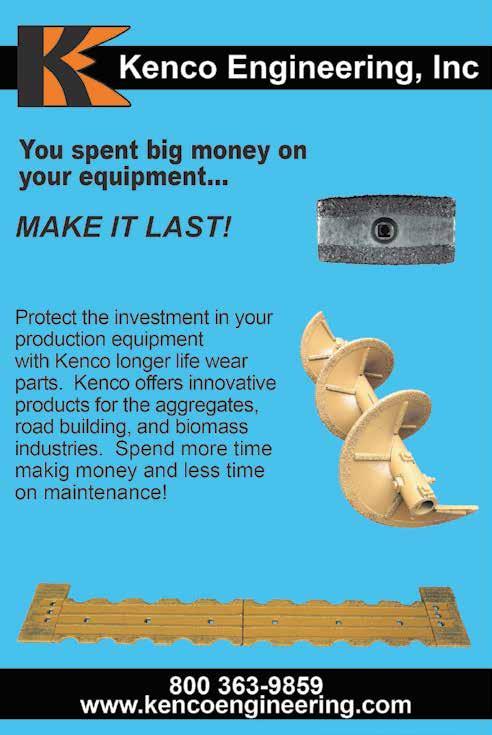
• Wyoming State Highway Department; and
• the National Park Service. Would you believe the 1.5-day seminar had a registration fee of $19 back then? The fee went up to $21 by 1981, according to the website. “For the first 24 years, the event was known as the CSU Asphalt Paving Conference. The early years of the conference centered on asphalt industry suppliers, producers and other members of the Asphalt Institute. In addition, public sector agencies at the Federal, state, and local level were encouraged to attend and participate.”
Over the years, a host of industry experts have participated in the conference, sharing knowledge and best practices with the asphalt world. The site lists some of the big names readers will recognize. In the 1990s, paving and compaction experts Chuck Deahl from Bomag Americas and John Ball of Top Quality Paving & Training teamed up to offer down-to-earth how-to presentations to standing-room-only audiences year after year. It’s the kind of content the conference strives to offer to this day, teaming up with speakers to ensure attendees walk away with good education to improve their bottom line.
CONEXPO-CON/AGG
MARCH 14-18
Las Vegas Convention Center www.conexpoconagg.com/ Make sure you put the AsphaltPro Booth C32025 on your list in Vegas. There’s a whole show section coming up in the March/April edition where we’ll outline what our advertisers have in store for asphalt professionals.


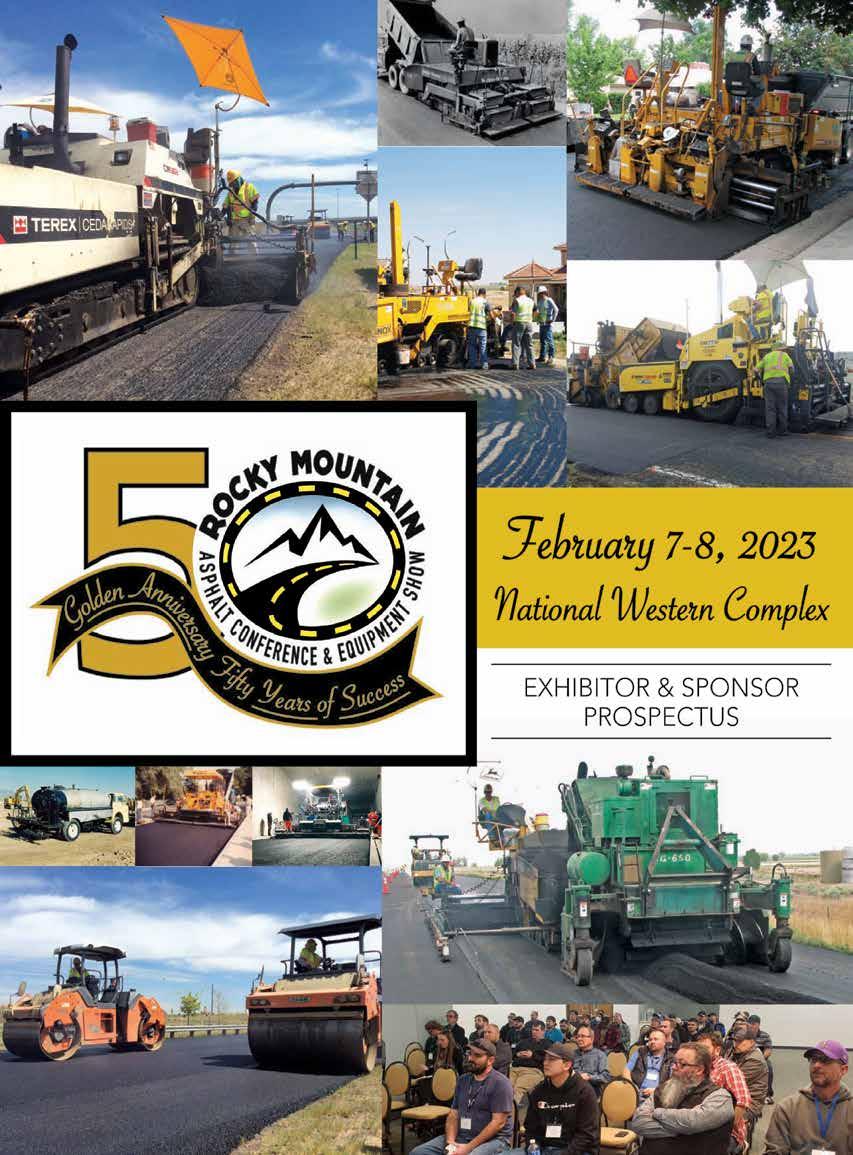
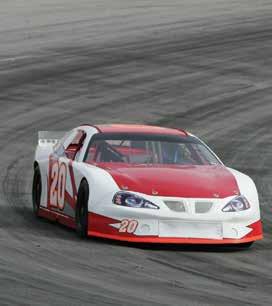








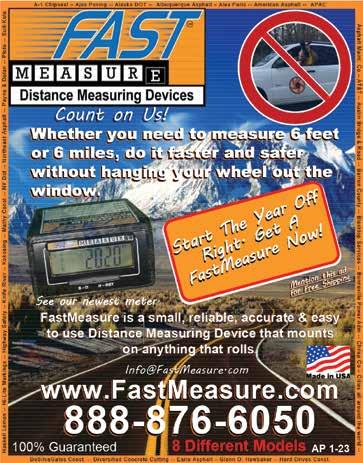
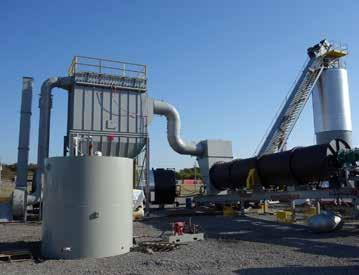

Ahern 55 ALmix 7
Asphalt Drum Mixers, Inc 22, 23


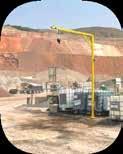
Astec Industries Inside Front Cover, Inside Back Cover
B&S Light 38, 39 Blaw-Knox 9
Bomag 17
BROCK 57
Clarence Richards Company 55, 56 Command Alkon 29
CONEXPO-CON/AGG 51 CWMF 3, 25
Eagle Crusher 45
Fast Measure 55
Gencor Industries, Inc 4 GSSI 19 KENCO 50
Meeker 37 Meyer Labs 56

NPE 53



Olson-Homestead Valve 13
Pugmill Systems 41

Reliable Asphalt Products Back Cover RMACES 52
Sripath Technologies 15 Stansteel 11, 49 Systems Equipment 21, 47


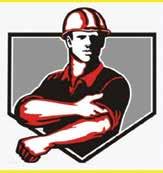
Tarmac International 35
Top Quality Paving 54 Weiler 31 WEM 33 Willow Designs 54 Wirtgen 27 Women of Asphalt 43
AsphaltPro’s advertiser index is designed for you to have quick access to the manufacturers that can get you the information you need to run your business efficiently. Please support the advertisers that support this magazine and tell them you saw them in AsphaltPro magazine.









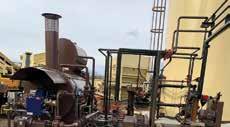

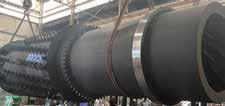

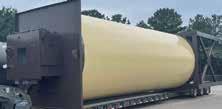
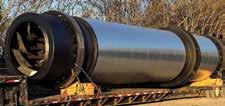
Raken Streamlines the Daily Report Process
BY SARAH REDOHLRaken is a digital construction reporting software and app from Raken, Carlsbad, California, that aims to streamline project management and communication on construction projects. The platform can be used to collect, organize and share real-time data from the field.
“Daily reporting is our number one feature,” said Tony Bichai, construction specialist at Raken. “As the supervisor or project manager is going about the day, they can document everything that’s happening out in the field in Raken, step by step.”
Daily reporting starts with the work log, where the user inputs what happened on-site, where it took place and other necessary details. Raken automatically fills in as many details as possible, including the date, project name, weather and information about who is completing the form.
The user can fill in additional details by typing them in, using Raken’s voice-to-text feature, or taking time-stamped photos and videos. They can also attach production documents to the daily report via web or mobile.
MORE THAN REPORTS
Although the daily report is the core of Raken, the platform can also be used to track time, complete checklists and surveys, document safety talks and track production.
To use Raken’s time card feature, the contractor can bulk upload crews and allocate hours to entire teams at once or add members and adjust hours from the app for individuals filling in for sick co-workers, staying late, or arriving early. They can toggle between regular hours, overtime or double time with one tap, Bichai said. Once entered into Raken, users can assign time worked to cost codes for detailed payroll processing, time management and production tracking.
Raken can also be used to complete checklists, ranging from PPE reviews, project safety checklists and activity risk assessments to equipment walkarounds, installation procedures and worksite incident reports. “There are lots of steps in the construction process
and it can be easy to miss things,” Bichai said. “A checklist gives the crew something they can run through step-by-step.”
The app contains a number of pre-built digital checklists, as well as custom templates for users to create their own checklists. Within this feature, Raken also enables field teams to respond to pre-established questions directly in the app and the office can see answers as soon as the checklist is completed and signed.
Completed checklists and surveys can also be attached to the daily report within Raken, as can the delivery of toolbox talks. The platform houses a library of more than 100 prebuilt toolbox talks and allows users to upload their own safety toolbox talks. Management can assign toolbox talks to specific projects or company-wide, and field superintendents will receive the assigned talk via the Raken app.
Once the toolbox talk has been delivered to the crew, the foreman or superintendent selects the workers who attended the talk and passes around the phone or tablet to collect digital attendance signatures to be included in the daily report. For crews that prefer to capture attendance signatures on paper, the foreman can take a photo of the sheet and Raken will automatically include it in the report for that day.
TRACK PRODUCTION
In addition to the features related to Raken’s daily reporting tool, capturing this data can help contractors track field productivity in real time by bringing equipment, time and material tracking into one location. Bichai said this not only enables its users to utilize historical
production data to make informed decisions in the future, but also to identify and correct issues as they arise.
For example, one of Raken’s asphalt contractor customers used the platform to check the status of an airport project midway through its completion and noticed he was burning labor hours based on how much material was installed. “He called the foreman and learned it was because there was another subcontractor on the job who was delayed and this delay was preventing their crew from completing their work in an efficient manner,” Bichai said. “That enabled him to bring this up to the client and general contractor and explain how the delays would impact the rest of the project.”
One feature Bichai thinks is particularly useful in this regard is Raken’s automatic projected hours feature based on material installation by hours worked to tell the user how far ahead (or behind) schedule they are.
Production tracking can also assist in bidding, Bichai said. “You’ll be able to see how accurate past estimates for similar work were and estimate more accurately for future jobs.”
EXPANDED FEATURES
The Raken team continues to add new features, whether in the form of integrations with other platforms or Raken’s new chat feature similar to WhatsApp or Facebook Messenger. “Users can create project groups, a group for all foremen, etc. to text from within Raken to make group chat easier and enable people at their computers at the office to chat there, too,” Bichai said
Raken also aims to make it easier for subcontractors to comply with the prime contractor’s daily reporting requirements, if needed. “Subcontractors can use Raken free of charge if the general contractor uses Raken and invites them to the project in Raken,” Bichai said. “You’re able to see not just your company but also the daily reports from the subcontractors.”
“Our clients have found that the professional reports they generate with Raken build trust with their prime contractors, sub-contractors and clients,” Bichai said. “The daily reports from our platform show you’re on top of the day-to-day.”
“KEEPING CUSTOMERS INFORMED WITH CONSISTENT STATUS UPDATES AS WORK IS COMPLETED IS ONE OF THE BEST WAYS TO MANAGE THEIR EXPECTATIONS AND KEEP ALL STAKEHOLDERS ON THE SAME PAGE.”—TONY BICHAI
BUILT TO CONNECT
Efficiency and Productivity
Designed with safety and operator comfort in mind, the SB-3000 Shuttle Buggy ® material transfer vehicle features adaptive cruise control, bright LED lighting, four-wheel steering for easy transport and ground-level maintenance access for added convenience. Operators can rely on clear sightlines and the ground operator is safely protected inside the structure of the machine. The Roadtec SB-3000 is the perfect blend of traditional craftsmanship and modern technology.
Scan to learn more about the SB-3000.
